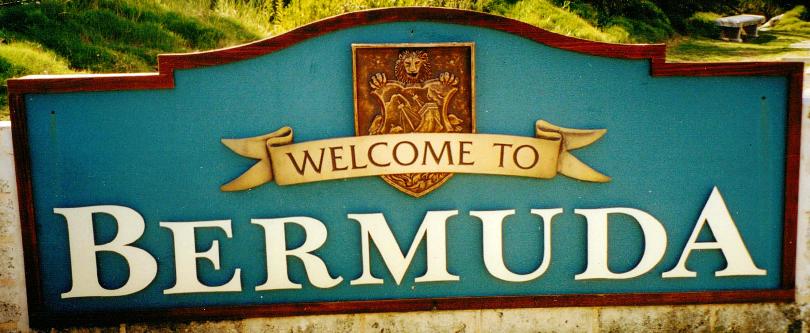
Click on graphic above to navigate the 165+ web files on this website, a regularly updated Gazetteer, an in-depth description of our island's internally self-governing British Overseas Territory 900 miles north of the Caribbean, 600 miles east of North Carolina, USA. With accommodation options, airlines, airport, actors, actresses, aviation, banks, beaches, Bermuda Dollar, Bermuda Government, Bermuda-incorporated businesses and companies including insurers and reinsurers, Bermudians, books and publications, bridges and causeway, charities, churches, citizenship by Status, City of Hamilton, commerce, communities, credit cards, cruise ships, cuisine, currency, disability accessibility, Devonshire Parish, districts, Dockyard, economy, education, employers, employment, environment, executorships, fauna, ferries, flora, former military bases, forts, gardens, geography, getting around, golf, guest houses, highways, history, historic properties, Hamilton, House of Assembly, housing, hotels, immigration, import duties, internet access, islands, laws, legal system and legislators, main roads, marriages, media, members of parliament, money, motor vehicles, municipalities, music and musicians, newcomers, newspaper, media, organizations, parks, parishes, Paget, Pembroke, performing artists, residents, pensions, political parties, postage stamps, public holidays, public transportation, railway trail, real estate, registries of aircraft and ships, religions, Royal Naval Dockyard, Sandys, senior citizens, Smith's, Somerset Village, Southampton, St. David's Island, St George's, Spanish Point, Spittal Pond, sports, taxes, telecommunications, time zone, traditions, tourism, Town of St. George, Tucker's Town, utilities, water sports, Warwick, weather, wildlife, work permits.
![]()
By Keith Archibald Forbes (see About Us)

Some 2014 Bermuda Flowers postage stamps
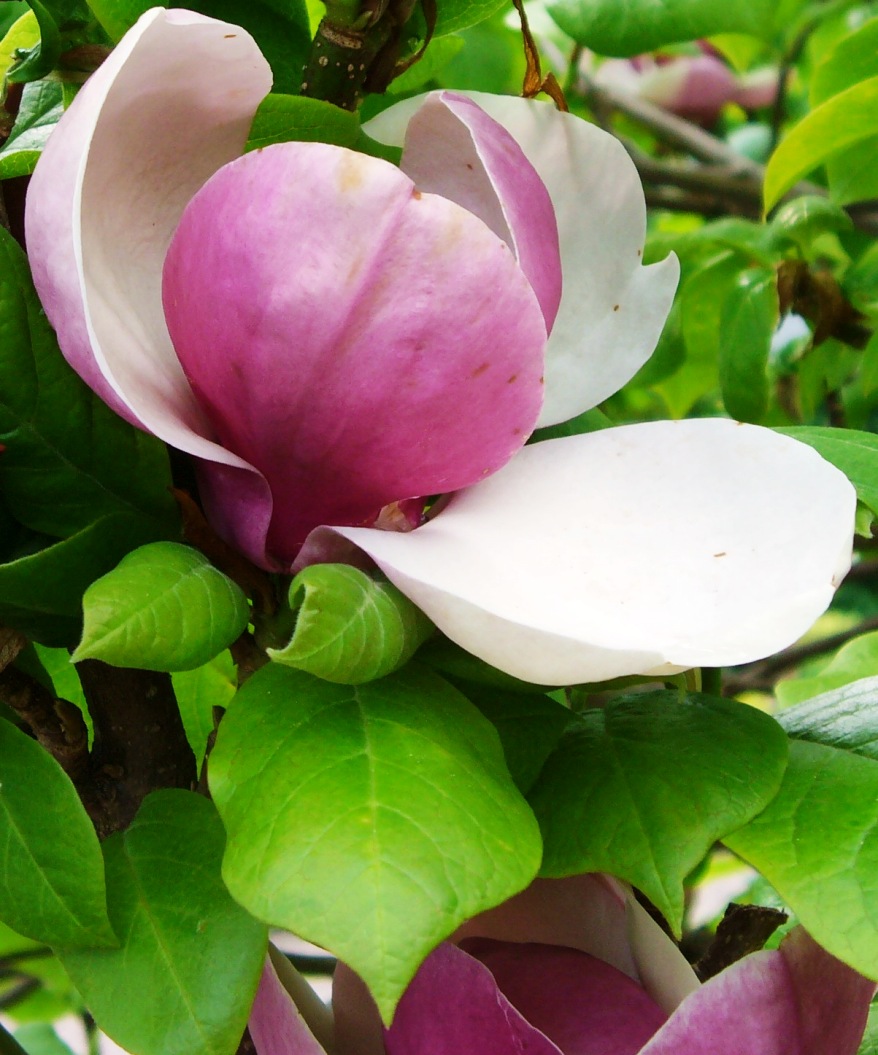
A Bermuda flower. 2009 Photo by this author, exclusive to Bermuda Online
Bermuda’s native flora and fauna originates from south-eastern North America and the Caribbean, supplied by wind-borne dispersal and via the Gulf Stream. Yet despite this isolation, and small size, over 8,000 species have been recorded from the island and its surrounding waters. Due in great part to human colonization and development resulting in one of the world’s most densely populated islands (1,500 people per square kilometre); major threats to the native flora and fauna have been identified as habitat loss or deterioration, and competition with invasive species. This has resulted in the known extinction of 25 endemic species, the decimation of an estimated 200 native species and naturalization of at least 1,200 exotic terrestrial species. Even more frightening is the fact that Bermuda’s undeveloped land area is now dominated by 22 plant species considered invasive, out-competing and overshadowing the native flora. Population numbers are continuing to decline for several species, and without active intervention, further extinction may occur. A most critical example of this is the case of the endemic Governor Laffan’s fern (Diplazium laffanianum); only one mature specimen of this fern species remains in Bermuda, maintained in a nursery environment by the Department of Parks. Although not as dire a case, the yellow wood tree, prized for its timber value by early settlers and exported to England for cabinet wood, also suffered a dramatic decline leading to a present day total population of 23 mature trees. Belonging to the citrus family, the yellow wood tree is an asset to one’s backyard, recorded to have a pleasant aroma when in bloom.
Bermuda, in USDA Zone 11, is at 32 degrees North, with about 50 inches of rain annually. It has a sub-tropical climate. A few species of plants and trees are endemic, many are native meaning they arrived naturally - by natural occurrence without the aid of mankind - but can be found in other places too. Others are naturalized, meaning they were introduced by man and later established on their own. They include hedges of red, white, pink and yellow oleander, Surinam cherry - highly invasive - and hibiscus in different colors. The vast majority that were introduced, see Bermuda Flora. There is no wet and dry season, but summer droughts and winter gales are common. It has a sub tropical and frost free climate. There is a constantly high humidity, especially from May to October, but no frost or snow. Temperatures rarely drop below 50 degrees F or rise above 90 degrees F. The surrounding Atlantic Ocean and proximity of the Gulf Stream exert a moderating influence on the climate. Bermuda soil is alkaline, limestone in origin and with depth from two to three feet to an inch or less. Below it is solid limestone. Shallow soil and periodic droughts of up to eight weeks can test and defeat the tolerance of plants. Bermuda has Asia's subtropical regions but no orchids of its own. Plants to avoid. Bermuda has numerous areas on trails, woodlands and even private roads with plants including poison ivy (Toxicodendron radicans) and stinging nettles, very similar in size and shape to those in North America. Keep well clear of them. Worst garden pests. They include mealy bugs on crotons, controlled with Volk oil; black spot on roses and hemispheric scale on hibiscus, kept at bay with a mild solution of malathion. Plants to avoid include poison ivy (Toxicodendron radicans) and stinging nettles, very similar in size and shape to those in North America. They are on numerous trails, woodlands and roads.There are no tall trees like dogwood, oak, sycamore or maple, or flowering shrubs like rhododendrons or azaleas. But see many other types common to sub tropical climates. They also grow in less accessible meadows and pastures in coastal or marshy areas. Trees such as apple and breadfruit not grown in Bermuda. There are some mango trees, not many. Nor is any sugar cane grown, unlike in Caribbean Islands 900 miles to the south. However, in Bermuda's earliest days (early 17th century, Bermuda exported tobacco for years and later once had - until the early 20th century - a significant domestic and mostly USA agricultural market, in oranges, lemons, grapefruit, bananas and avocado. There are no forests, but some attractive woodland and wetland areas - and coastal areas. Some are national parks. The Bermuda Government levies an extremely high import duty on all imported plants (for example, orchids) and on agricultural equipment for farmers and those who tend gardens.
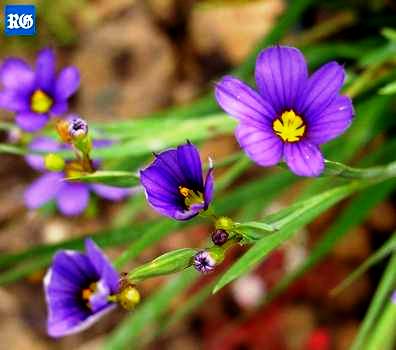 Sisyrinchium
iridioides. Bermudiana. Bermuda's national flower.
A
member of the iris family first recognized by Carolus Linnaeus as different from
the American blue-eyed iris. This was confirmed in 1884. In the USA and UK, known as
Sisyrinchium.
Sisyrinchium
iridioides. Bermudiana. Bermuda's national flower.
A
member of the iris family first recognized by Carolus Linnaeus as different from
the American blue-eyed iris. This was confirmed in 1884. In the USA and UK, known as
Sisyrinchium.
In Bermuda, USA and UK, the sisyrinchium is happy in poor to moderately fertile alkaline soil and is common in clumps in gravel gardens, rock gardens, trails and sunny borders. Referred to as endemic, but this is wrong. The official national flower. A small herbaceous plant with leaves six to eight inches long. The flowers - usually in April, for weeks - have six purple petals that are yellow at the base. They give the center its distinctive yellow color. In the USA (mostly found in US Zones 7-8) and United Kingdom, it is a semi-evergreen rhizomatous perennial with slender, sword-shaped leaves arranged in fans. Leaves are about 10 inches long, same length as the upright flower stalks that appear for weeks in Bermuda in spring and in the USA and UK in summer.
Bermuda’s national flower is struggling for survival — in Ireland. According to the Irish Times the Bermudiana, generally considered to be endemic to Bermuda, has been flowering in Ireland for more than 150 years. “What nobody seems to know for sure is whether it’s native to Ireland and was introduced to Bermuda, or vice versa,” the story said. “Given its flowering habits — the star like petals open only on sunny days — you’d expect it to prefer Bermuda’s humid subtropical climate to the uncertainties of Irish weather.” The Bermudiana, was first reported in Ireland in 1845 where it is known as blue-eyed grass or by the Irish name feilistrín gorm, which translates to “little blue iris”. The plant is a common sight in Bermuda but it is considered endangered in the Republic of Ireland and it is protected by legislation in British-run Northern Ireland.
Conor McKinney, a landscape manager with the conservation group Ulster Wildlife, told the Irish newspaper that the flower has faced challenges in Ireland, in part because of farming habits in the area. “It won’t open up on cloudy days, only when the sun is high in the sky. And it’s very small and quite delicate — so it is easily overlooked,” he said. “Many sites were seeded with very aggressive rye grasses which overtake the native species, of which blue-eyed grass would be one. Farmers were often told to spray fields ‘until that purple flower disappeared’. That was regarded as good farming practice.”
Bermuda's national flower, pictured above right.
Some well-known species, not native to Bermuda but doing well, can be planted in February. They include gaillardia, gazania (some flower all year), gerbera, geraniums, gladioli, globe amaranth, globe gilia, godetia, gypsofila, hibiscus (variegated and other, as bushes or hedges), hollyhock, honeysuckle, hydrangeas, Carpobrotus chilensis (ice plant), impatiens, lantana, larkspur, lathyrus, marigold (African and French), match-me-if-you-can, narcissus, nasturtium, Natal plum, nicotiana, night blooming cereus, oleander (as hedges or bushes), pansy, petunia, phlox, passion flower, periwinkles, pittosporum, plumbago, poinsettias, portulaca, prickly myrtle, red tassel flower, rose everlasting, rudbeckia, scarlet cordia, salipigossis, salvia, scabiosa, snow plant, snow-on-the-mountain, Spanish bayonet, spider flower (cleome), star-of-the-veldt, statice, stock, sweet pea, sweet William (in Scotland, Stinking Willy), trumpet flower vines, verbena, vinca, viola, Virginia creeper, yucca, zinnia. Observe many of these on roads and Bermuda Railway Trail, also in hotel and guest house gardens and in public parks and woodlands.
![]()
Bermuda - a floral sampler. Elizabeth W. Curtis. 1978. Illustrations by Diana Amos.
Bermuda: A Gardner's Guide. 2002. Garden Club of Bermuda. Many illustrations and color photographs. $45.
Bermuda's Botanical Wonderland. Christine Phillips-Watlington. 1996. Bermudian Publishing Company Ltd. The most valuable resource for botanists and gardeners since Britton's "Flora of Bermuda" in 1918. Illustrated.
Bermuda, Her Plants and Gardens. Jill Collett.
Bermuda's Seashore Plants and Seaweeds. Wolfgang Sterrer and A. Ralph Cavaliere. 1998. Published by Bermuda Natural History Museum and Bermuda Zoological Society. 269 pages. About $15.
Bulletin of Marine Science. Bermuda Natural History Museum. The issue prior to July 14, 2000 had an inventory by Dr. Wolfgang Sterrer on the number of species (at least 8,299) of flora and fauna in Bermuda, of which 4,597 are marine and 3,702 are terrestrial.
Flora of Bermuda. Nathanial Lord Britton. New York, Scribners. 1st edition, 1918.
Flowering Trees of the Caribbean. 1951. 125 pages. Illustrated.
Flowers in Bermuda. Cunninghame, Judy. 1969. Longtail Publishers. 12 plates of artwork on Bermuda's flowers.
Flowers of Bermuda. Hannau. No date. 64 pages and illustrated.
Flowers of Bermuda. Middleton. c. 1927. E & C. Tucker, Bermuda. 18 pages, illustrated.
Marine Fauna and Flora of Bermuda. Dr. Wolfgang Sterrer. 1986. Wiley Interscience, New York. Out of print.
Plants of the Bermudas or Somers Isles. 1883. By Oswald Reade, a British pharmacist then working at the Royal Navy Hospital, Dockyard, Bermuda.
The Bermuda Garden. Whitney (editor). 1955. Garden Club of Bermuda, 231 pages. Illustrated.
The Bermuda Jubilee Garden. Edited by Elfrida L. Wardman. 1971. Published by The Garden Club of Bermuda, to mark its 50th anniversary. Printed in Scotland by Robert MacLehose and Company Limited. The University Press, Glasgow. 349 pages. Illustrated.
The Conspicuous Flora and Fauna of Bermuda. Dr. Ralph Cavaliere, Ph.D.
The Story of Bermuda. Strode, Hudson. 1932. New York, Random House. Fish scale cover, 374 pages, with illustrations by Walter Rutherford. Strode spent three years in Bermuda then returned to the University of Alabama where he was Professor of English. He also describes Bermuda's fishes, flora, open spaces and trees of the period.
Trees and Plants of the Bermudas. Zuill, 1933. Published by Bermuda Book Store, Hamilton.
![]()
All the following were originally imported - unless mentioned otherwise - but do well.
![]()
Acacia. Very few here. (One is a Golden Mimosa). A native of Australia where they are wattle trees. Thorns are nearly 2 inches long. Fruit is like a pea or bean, but is unheard of here.
Acalypha hispida. Chenille. Red-Hot Cattail. Shrub with narrow pendant spikes densely covered in red flowers. Spikes are about one foot in length and shrub can grow 10 feet high.
Acalypha godseffiana. Or Match-me-if-you-can. Introduced to Bermuda, not a native but does well here, now common.
Acrolinium.
Adenanthera pavonina. Red sandalwood tree. A bead tree. Not common locally.
Adiantum bellum. Maidenhair fern. Endemic. One of the 19 fern species native to Bermuda. The most abundant, found throughout the island in crevices, cliffs, along roadsides, under rock ledges and on hillsides - almost anywhere offering shade and moisture.
African violet. See Saintpaulia.
Agapanthus. Some splendid specimens have been seen growing in local gardens.

Photo by the author exclusively for Bermuda Online.
Ageratum
Aguja. A common ground cover.
Allamanda
Aleurites moluccana. Candlenut Tree. Native of Southeast Asia, naturalized in the tropics, State tree of Hawaii where it is also known as the kukui tree. See one at Marsh Folly Road near Dutton Avenue and at the Swizzle Inn parking lot. It can grow to 60 feet. Flowers are small, creamy white and in large clusters. Fruit, on the tree in late June, is about 2 inches in diameter, covered with a thick green flesh with one or two nuts inside, rich in unsaturated oil.
Amaranthus
Aloe.
Alyssum
Amaryllis
Asparagus densiflorus. Asparagus fern. One of Bermuda's most invasive plants. Native of South Africa. Part of the lily family.
Belladonna lily, family Amaryllidaceae. Native of South Africa but grows well in Bermuda.
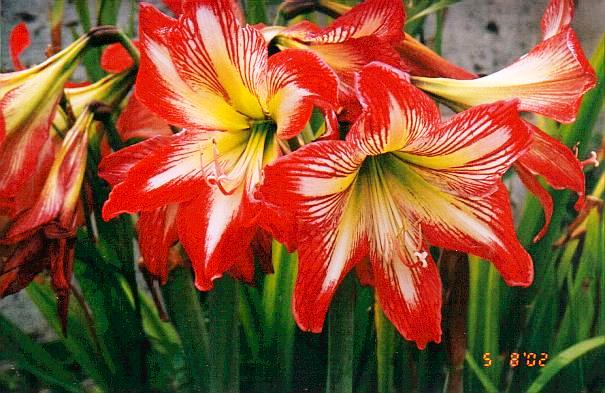
Photo by the author exclusively for Bermuda Online.
Anacardium occidentale. Cashew Nut tree. Not common, some were once planted in a rural area of St. David's known as Cashew City. A few years ago, one was planted in the Bermuda Perfumery Gardens.
Annona cherimola. Cherimoya. One of the Annona species. Native of Peru. Produces good fruit.
Anonna muricata. Pineapple custard/Soursop. Not common but one was planted a few years ago in the Bermuda Perfumery Gardens.
Anonna reticulata. Custard apple or bullock's heart.
Annona squamosa. Sugar apple or sweetsop. Native of West Indies and Central America. Several can be seen in Somers Gardens and old Bermuda gardens Produces good fruit.
Antigonon leptopus. Corallita Vine. Native of Mexico. Common, introduced before 1918.
Anthurium. Grows well in high-quality sheltered gardens.
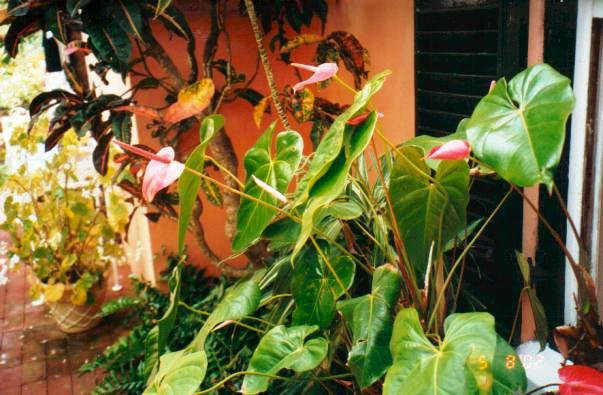
Photo by the author exclusively for Bermuda Online.
Antirrhinum. Snapdragon.
Araucaria heterophylla. Norfolk Island Pine. Tallest tree in Bermuda and can grow 200 feet high. It is called such because it was originally from this island in the Pacific, off New Zealand. The trunk can be seven feet in diameter.
Argemone mexicana. Mexican Poppy, or stinging thistle and queen thistle, it flowers in many Bermuda areas. Weed.
Aristolochia spp. Introduced, not common, various names such as Dutchman's pipe, snakeroot, calico flower and pelican. Fast-growing evergreen vine, unusual flowers.
Arundo donax. Cane grass or cow cane. It grows up to 20 feet high. The canes can be used for stakes.
Asclepias currasavica. One of two types of milkweed. Grows about three feet high. Attractive to monarch butterflies.
Asclepias physocarpa. Taller type of milkweed, white-flowered tennis ball plant which grows to five to 6 feet tall. Attractive to monarch butterflies.
Asimina triloba. Paw paw. Very common in Bermuda. Temperate fruit tree, native to eastern North America.
Asparagus fern. Non-endemic, introduced, invasive.
Aster
Athyrium goeringianum. Pictum. From Asia.
Aubrieta
Australian Bottle Brush. So called because the flowers are like those of a bottle brush.
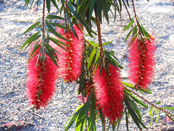
Averrhoa carambola. Star Fruit. Not common.
Avicennia nitida, otherwise Black Mangrove, is a gray-foliaged evergreen tree growing up to 40 feet high with numerous air-breathing roots growing upwards to 6 inches from the mud around the base of the trunk. It grows in the mud of salt lagoons and bays. Black mangroves are slightly smaller than the red variety, with breathing roots rising straight from the water. They also supply air to the underwater roots. On the back of their leaves, you may see salt crystals. This is how the tree gets rid of its salt in the water it consumes. It is an excellent tree for bees and birds. See more under Mangroves.
Avocado. See under "Persea americana."
![]()
Baby blue eyes
Baccharis glomeruliflora. Doc Bush. Native shrub.
Bachelor's buttons
Balsam
Bambusa Species (Graminae). Bamboo. Different types flourish and can reach quite high. Bambusa multiplex is large, growing to 30-50 feet high. Arundinaria japonica and Arundinaria nitada grow to about 8 to 10 feet high. Pygmy bamboo, sasa pygmea, is a few inches high and can be used as a ground cover.
Barleria cristata. Sometimes referred to as a Philippine violet but a native of India. Imported before 1918. A small shrub with blooms.
Bauhinia punctata. Nasturtium Bauhinia. Spreading, deciduous, woody shrub, up to 10 feet high. Wild. Prolific. Colorful blooms from peach to deep red, about 3 inches across. Good nectar plant for butterflies.
Bauhinia variegata var.candida. Purple-flowered. And Bauhinia monandra. Orchid trees. Introduced from Trinidad in 1874. First two are now common sight along roads. The last is not. One was planted in Bermuda Perfumery Gardens.
Bay bean. Sprawling vine. Especially in the dunes behind beaches. Native to Bermuda, southeast USA, Caribbean and tropics of America. Confused with but is not the seaside morning glory or bay grape.
Bay Grape. Or Sea Grape. See Coccoloba uvifera. Very common in certain beach areas, particularly Grape Bay, Paget.
Beaumontia grandiflora. Known as Easter lily vine, Herald's Trumpet and Easter Herald's Trumpet. Not a lily at all. Imported.
Begonia spp. Named after Frenchman Michel Begon. Found in the French West Indies (Antilles) by an English plant collector.
Bells of Ireland.
Bermuda Arrowroot. At one time an important crop.
Bermuda bean. Endemic. Not common. In the Leguminosae family.
Bermuda cedar. Juniperus bermudiana. Tree, once used for shipbuilding by the Royal Navy and commercially locally. Declined hugely in the 1940s owing to an imported blight, now making a limited come-back
Bermuda Palmetto. Sabal bermudana.
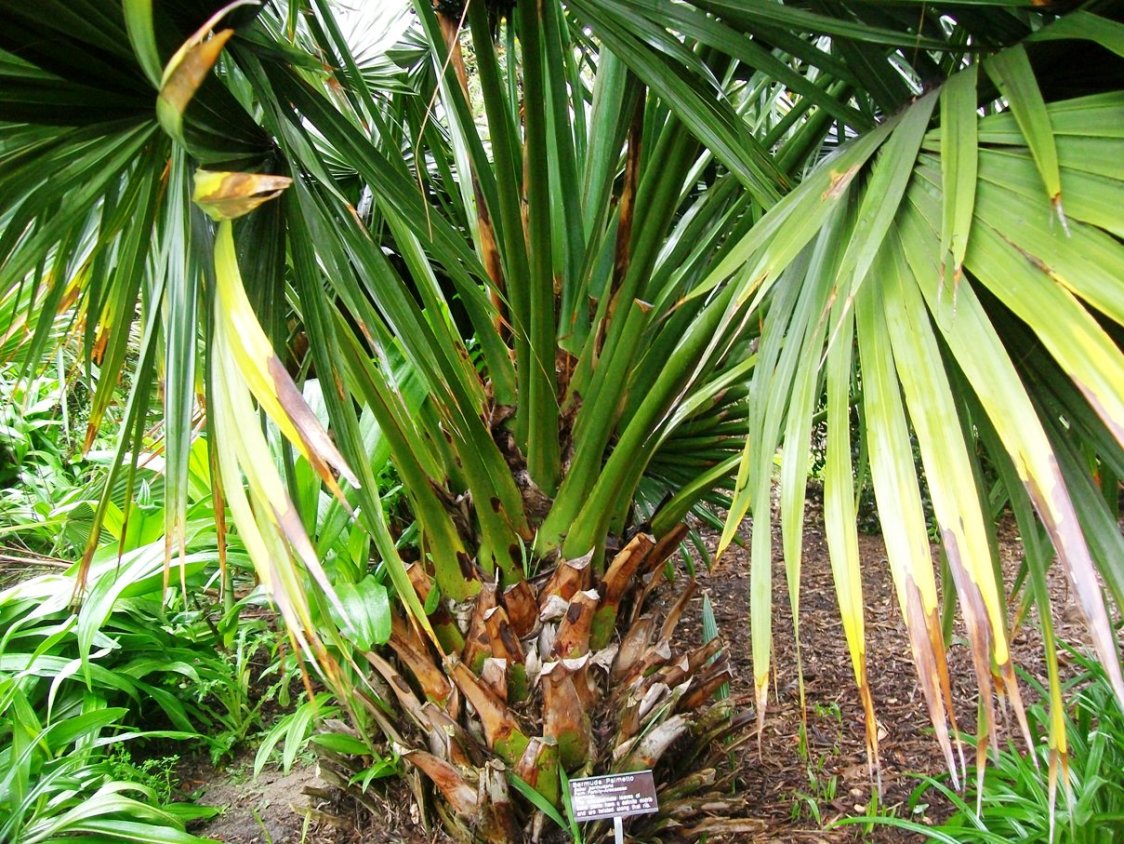
Bermuda Onion. First recorded being grown here in 1609. Early sailors ate an onion a day to prevent the dreaded scurvy disease.
Bermuda Sedge. Endemic and very rare. Unfamiliar to most Bermudians and tourists, similar to a small, long-bladed grass. Once in wooded marshy areas, now mostly in Abbott's Cliff, Paget Marsh and Nonsuch Island. Flowers and sets seeds in spring but rarely propagates, probably because of rats which love it.
Bermuda Shield Fern (Goniopteris bermudiana). One of the 19 fern species native to Bermuda among the 12,000 species in the world. Not common, known only in a handful of places in the Walsingham/Castle Harbour area.
Bermuda Snowberry. Chiococca bermudiana.
Bermudiana. Sisyrinchium bermudiana.
Bird of Paradise. Attractive to visitors, especially the orange color.
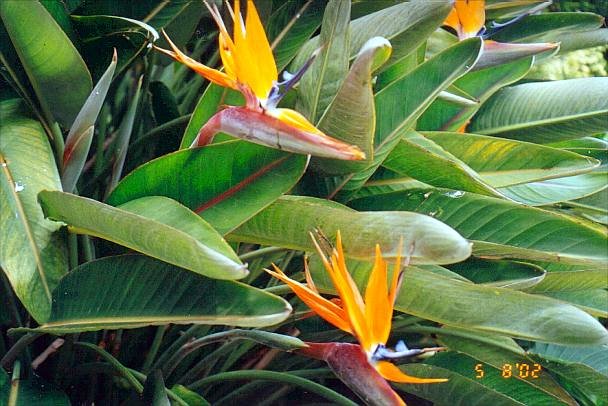
Photo by the author exclusively for Bermuda Online.
Bird's eyes
Bixa orellana. Lipstick Tree. Not common. One was planted in Bermuda Perfumery Gardens.
Blanket flower
Blighia sapida. Akee.
Bougainvillea (Bougainvillea spectablis). Native of Brazil, named after L. de Bougainville, a French 18th century navigator and explorer. A strong growing climbing vine with spiny stems and round leaves. Purple flowers are the most usual in Bermuda. What most people think are the flowers are, in fact, bracts, or modified leaves, that surround the long, narrow, inconspicuous and tubular flower. The latter is white at the very top and below, is the colour of the bract. It is these papery bracts that give Bougainville its other common name of paper flower. The flowers are borne in threes. Other varieties include red, coral and salmon, blooming at most times of the year. A gorgeous display of them is held every Christmas in one of the buildings of the Bermuda Botanical Gardens. Most nurseries have them then.
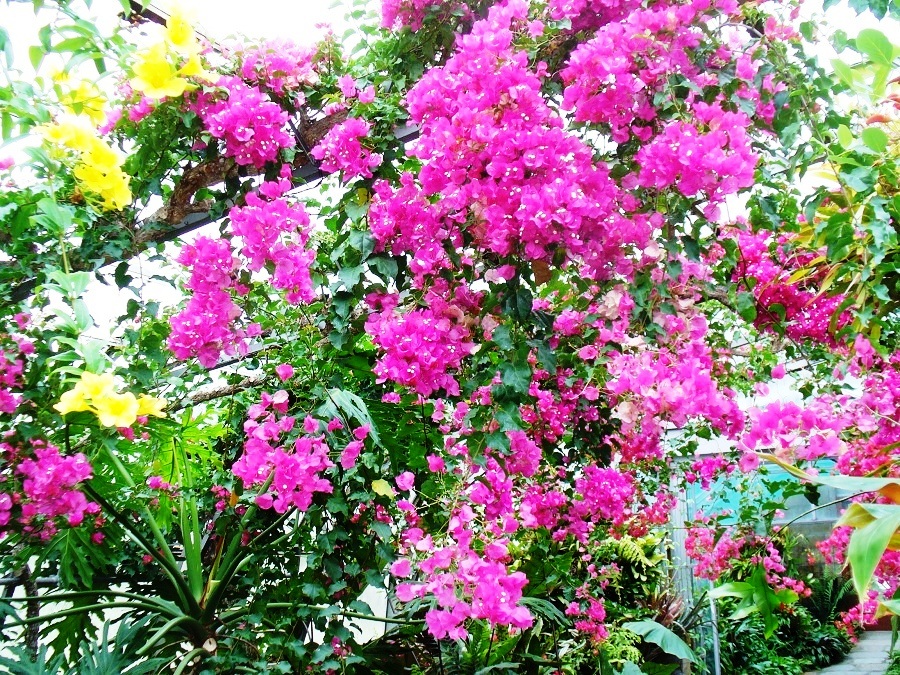
Bougainvillea center and right with yellow hibiscus on left. 2009 Photo by the author specifically for Bermuda Online
Borago officinalis. Borage. Bee plant, or bee bread in UK. Blue flowers, textured leaves.
Brachychiton acerifolius. Australian Flame Tree. From New South Wales. With spectacular scarlet-red flowers in loose clusters. Look for a superb specimen at Bermuda Perfumery Gardens.
Brassaia actinophylla. Umbrella Tree. Schefflera, a popular ornamental, also known as Australian or Queensland umbrella tree, Octopus tree and starleaf. Native to Queensland, introduced to Bermuda after 1918. Can grow to 40 feet. Specimens are at Botanical Gardens. There is also a dwarf umbrella tree, B. arboricola, newer. Fairly common, with orange-colored fruit.
Brunfelsia australis. Yesterday, Today & Tomorrow. Sense shrub reaching 5 feet with blooms of 1 inch across. Fragrant flowers change in color, first purple then fade to white.
Buddleia madagascariensis. Madagascar buddleia. A 15 feet high shrub, most common in the Castle Harbour area. Invasive. With hairy leaves and orange tubular flowers. Good nectar plant for butterflies.
Butterfly bush (Buddleia madagascariensis).
Buttonwood (Conocarpus erecta). A native of Bermuda, tropical North and South America and West Africa. Also known as sea mulberry or button mangrove. It grows out of Bermuda's coastal rocks and survives harsh conditions. It can be a shrub or a tree 60 feet high. It is deemed a mangrove and locally is often found on the inland side of red and black mangroves, as a tree. It does well in salt spray.
![]()
Cacti. Many types.
Caesalpinia pulcherrima. Pride of Barbados. Upright shrub, grows up to about 6 feet, with dramatic large brown spikes covered with read and jellow flowers.
Cakile lanceolata. Scurvy grass or Southern sea rocket, edible. Common on beaches, not the European plant of same name. Helps build sand dunes.
Caladium. A native of tropical America, grown for its ornamental foliage, or used as a bedding and pot plant. It likes partial shade and is in several areas of the Bermuda Botanical Gardens, along Front Street and elsewhere.
Calla lily
Calendula
Calliandra calothrysus. Fiery Powder Puff. Not common.
Callicarpa americana (Turkey Berry).
Candytuft
Canna lilies. Cannaceae, the canna family. Several ornamental or hybrids have brilliantly colored flowers in yellow or orange or red or salmon.
Canna indica. Shot Plant. Also known as cane shot or Indian shot. It is most often seen at the edge of fields or uncultivated areas. Native of tropical America, can grow to 4 feet high.
Cananga odorata. Ylang-Ylang. Not common.
Capsicum sp. Jungle Chile. Not common. One was planted in the Bermuda Perfumery Gardens.
Carex bermudiana. Bermuda Sedge.
Carica papaya. Pawpaw. Originally from southern Mexico and Costa Rica, widely grown on the tropics and sub tropics. It was first brought here on the immigrant ship Edwin in 1616. It is much smaller than a papaya but a member of the same family. Very common. In old Bermuda, the juice of the green fruit was used at home to treat ringworm and warts, or to make meat more tender (sold under the name of papain). Now it is cooked as a vegetable, or eaten raw when ripe (then a yellow orange color). It is also a good source of vitamin C. Most paw paws grow to less than one pound in weight, but occasionally can be over five pounds. Seeds can be saved and planted as new trees. Some grow wild.
Carnation
Carpobrotus chilensis, also edulis. Also Delosperma. Ice plant (most frequently) or tea fig. Very common in Bermuda, especially in areas near the North and South shores. Attractive, succulent perennial ground-creeping cover. Introduced, naturalized in Bermuda, Pacific and central coast of America ,Mexico, Chile, etc. but despite the name originally from South Africa. Long, fleshy triangular leaves and deep pink, or in Bermuda often purple, daisy-like flowers. Known in South Africa as Hottentot-fig, ice plant, highway ice plant, or pigface, and sour fig. Drought tolerant but lovely flower to fill in a troublesome dry area in your garden. Adds a bright splash of color to the drier parts of a garden and care is easy. Not called an ice plant because it is cold hardy, but rather because the flowers and leaves seem to shimmer as though covered in frost or ice crystals. The plants grow to be about 3 to 6 inches tall and 2 to 4 feet wide.
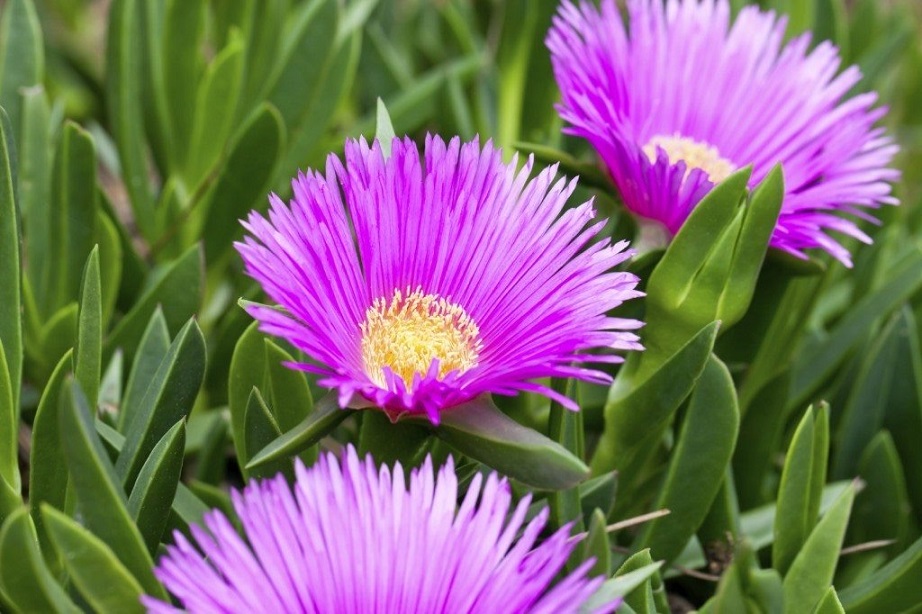
Ice plant
Cassava. Introduced to Bermuda by colonists in 1616, was the principal export in 1868–1869.
Cassia siamea. Popcorn Tree. Not native or common.
Cassia sp (Golden Shower). A good host plant for caterpillars and their butterflies (Cloudless Sulphur).
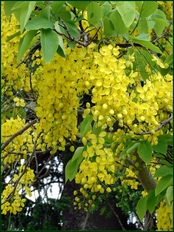
Cassine laneana, syn. Elaeodendron labeanum. Bermuda Olivewood. Endemic, an evergreen with leathery, dark green leaves, growing from 25 to 40 feet high. Its formal, perfectly rounded profile in maturity make it an ideal specimen tree for a formal garden. Clusters of attractive small yellowish-white flowers are seen in late winter or spring. It is slow-growing but can live to a great age. It is found growing naturally on rocky hillsides. A source of tannin. It does not do well in salt spray.
Castor Oil. Introduced to Bermuda by settlers in 1623. This plant has been used for thousand of years. The seeds/beans contain the oil which was often taken as a laxative but taken in large doses resulted in poisoning due to its alkaloid and protein content and polysaccharides which cause violent reactions in humans.
Casuarina equisitifolia. (Horsetail Tree, Australian Pine, Whistling Pine). Introduced in the 1940s and 1950s from Australia as windbreaks to replace the Bermuda Cedar. But highly aggressive and invasive, with prickles. Nothing can grow underneath.
Cat's Claw Vine. (Macfadyena unguis-cati). Named after a Scottish botanist. A native of Mexico, West Indies and Argentina. Often looks spectacular, blankets walls or climbs up trees and flowers in April. An evergreen vine with woody stems and large bell-shaped flowers, bright yellow.
Cattleya (corsage orchid). Pots only. One of the plants imported by the Bermuda Orchid Society
Celosia
Celtis laevigata. Southern Hackberry. Non-endemic, native. An elm-like deciduous tree growing to 35 feet.
Cedrela odorata. Tropical Cedar. Not common.
Centaurea
Century Plant (Agave spp). Native to tropical America, introduced to Bermuda from Mexico. Popular throughout Bermuda in gardens, on the roadside and in hotel properties. Many types grow here, including Agave americana, A. attenuata and A. sisalana. Known for their form, size and symmetry.
Chiococca bermudiana. Endemic. Otherwise known as Bermuda snowberry. Shrub. Outside Bermuda, only at Kew Gardens in south west London.
Christmas Cactus. In the Cactaceae or cactus family. Common.
Chrysanthemum
Cichorium intybus. Chicory. Also known as wild succory and blue sailors. Native to Europe. Grows wild. Edible but bitter, a salad green.
Cithraxylem spinosum. Fiddlewood. Originally from Tropical America to Argentina. Introduced by Archdeacon Spencer and planted in 1830 at Paynter's Vale Castle Harbour). It grows to about 50 feet high. Small, white and fragrant flowers cover the tree periodically. Can be damaged in windstorms.
Cineraria
Cinnamomum camphora. Camphor Tree. Lovely in Bermuda, with a round-headed shape and medium green leaves that when new are red and pretty. A good specimen is in the middle of the Sensory Garden of the Botanical Gardens. But no botanicals are made here from it.
Citrus Aurantifolia. Lime (fruit, not a European-type tree). Grows well in Bermuda, used in many local recipes, for sorbets, beverages, refreshing drinks, pickles, jams, jellies. Health benefits include weight loss, skin care, good digestion, relief from constipation, eye care, and treatment of scurvy, piles, peptic ulcer, respiratory disorders, gout, gums, urinary disorders, etc. Famous as a cure for scurvy.
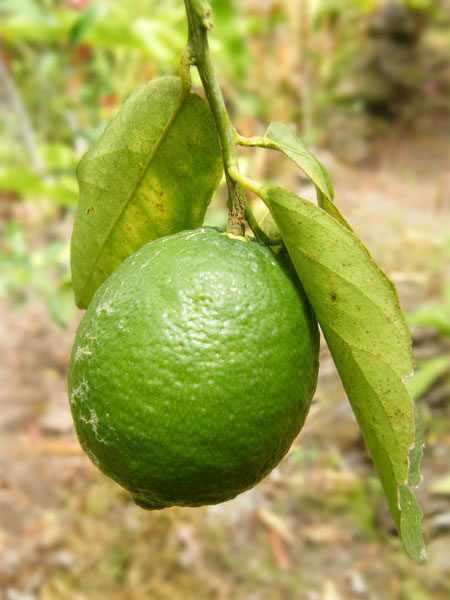
Clematis flammula. Clematis. A vigorous, weedy vine, noticed mainly when it flowers and fruits, generally in September. Flowers are scented.
Clerodendrum. Native of Java. Several of more than 400 species grow, including the bleeding glory bower (C. thompsoniae), scarlet glory (C. splendens), prickly myrtle (C. aculeatum).
Coccoloba uvifera. Bay Grape. Sea Grape. Non-endemic, native. A spreading coastal tree growing to 30 feet. Common, growing wild or as a part of hedges. It has large round glossy green waxy leaves 4-8 inches wide with red veining. Female plants pollinated by male plants produce small, white flowers that become grape-like clusters of green fruit that matures to purple. The plant can be pruned to form a single-trunk specimen tree, or clipped into a hedge. When clipped into a screen, the plant makes an effective windbreak. Bay grape is also tolerant of salty conditions, and is often grown in a shrub form to stabilize land near the beach and prevent erosion. The grapes are edible, not pleasant raw and can be made into a superb and distinctively-tasting jelly and jam. In Bermuda, berries ripen from October to December. Considered to have been the main reason for the naming of Grape Bay Beach, in Paget.
Bay grape tree off Bay Grape Beach in Bermuda. 2009 photo exclusively for Bermuda Online by this author.
Cochineal Cactus. In the Cactaceae or cactus family.
Cochlospermum vitifolium. Forest Peach. Not common.
Cocktail Plant. Psidium friedrichstahlianum.
Coconut. Does not grow as well as coconut 900 miles south in the Caribbean.
Codiaeum variegatum. Croton. Prolific. Can be six feet high, grown for striking colorful foliage. Flowers bloom in spring.
Coffea arabica. Coffee, grown in Bermuda for home use, not commercially. Introduced about 1750.
Coffea canephora. Coffee, grown in Bermuda for home use, not commercially. Introduced about 1750, another attempt was made in 1790. It failed as an economic crop because of the processes required to produce good coffee.
Colocasia esculenta. Eddo or dasheen or taro or elephant ear or kalo.
Coral plant. See Heath.
Coral Tree (E. crista-galli). Not common but there is a good one at the Aquarium, with dark red flowers. Another variety, E. variegata var. orientalis, also has red flowers and can grow 50 feet high. There are two specimens on the lower Camden lawn of the Bermuda Botanical Gardens.
Codiaeum variegatum. Croton. Can be six feet high. Flowers bloom in spring.
Cordia sebestena. Scarlet cordia. Only two types are grown in Bermuda. Vibrantly colored small flowering and ornamental tree. Can be seen on Reid Street near the House of Assembly and in the Bermuda Botanical Gardens. Apparently first planted by the now defunct Pembroke Arbour Society and found to a satisfactory street tree. With edible fruit.
Coreopsis
Cosmos. Good nectar plant for butterflies.
Cotton.
Crescentia cujete. Calabash Tree. Native of tropical America. Not common but in Bermuda by 1790. See healthy specimens at Camden Lawn in Botanical Gardens, junction of Verdmont and Middle Road, and Somers's Garden in St. George's. Irish poet and writer Thomas Moore is said to have courted in Bermuda under the Walsingham calabash tree (damaged in 2003 in Hurricane Fabian). The Royal Bermuda Yacht Club was founded under it. The calabash gourd was useful for holding water and making lanterns from candles. Pollination is thought to be done by bats.
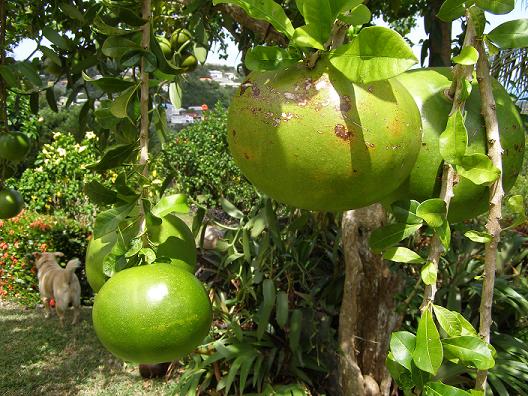
Calabash. 2009 photo exclusively for Bermuda Online by this author.
Crinum augustum. Lily. Drought-tolerant, needs almost no maintenance, has clumps up to five feet wide and nearly five feet high. With large bulbs.
Cryptostegia grandiflora and Cryptostegia madagascariensis. India Rubber vines. Two types. Native to Africa and the second to Madagascar specifically. But quite common. They have lilac-purple flowers held in clusters. Some have seed pods up to 4 inches long.
Cupressus sempervirens. Italian Cypress.
Cycads. Either male of female (usually female in Bermuda). In the Cycadaceae, or Stangeria and Zamia families. Wild cycads are threatened with extinction.
Cycas revoluta. Sago Palm. From South East Asia.
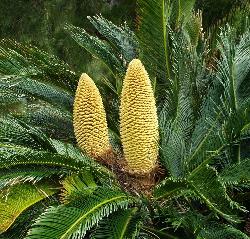
Sago Palm
Cymbalaria muralis. Coliseum ivy. Grows wild. Introduced.
Cymbidium. Pots only. One of the plants imported by the Bermuda Orchid Society
Cynodon dactylon. Bermuda grass. It produces the finest lawn and grows extremely fast in the spring and summer months. It grows on a wide range of soil types and also has good tolerance to salt spray. It withstand wear better than most grasses and if injured, recovers rapidly. Bermuda grass also responds well to fertilizing; however it requires more steady and consistent applications for a longer period of time, as opposed to St. Augustine. A slow release fertilizer (12-4-8) applied according to the directions, from April through September, is recommended.
![]()
Dahlia
Dalbergia retusa. Rosewood Tree. Not common. One was planted in the Bermuda Perfumery Gardens.
Daisies (African and other).
Daffodil. See Narcissus.
Dandelion. Good nectar plant for butterflies.
Datura arbora. Angel's Trumpet. A Native of Peru and Chile. Large shrub growing to 10 feet high, in various colors, with large, hairy leaves and trumpet-shaped flowers. Common in parks and some gardens. Flowers are usually white, 7-8 inches long.
Daucus carota. Queen Anne's Lace or Wild carrot. Grows wild.
Day lily. Good nectar plant for butterflies.
Delonix regia. Royal poinciana. A native of Madagascar, but grows freely in Bermuda as well as in many other countries such as Hawaii, where it is also known as the Flamboyant Tree, Flame Tree, Mohur Tree and Red Flame. It blooms in about July or August usually - and can reach 40-80 feet, spreading out to the side as well as high. One of Bermuda's most splendid trees and one of the top five in the world in beauty. A serious potential problem is the Pink Mealybug.
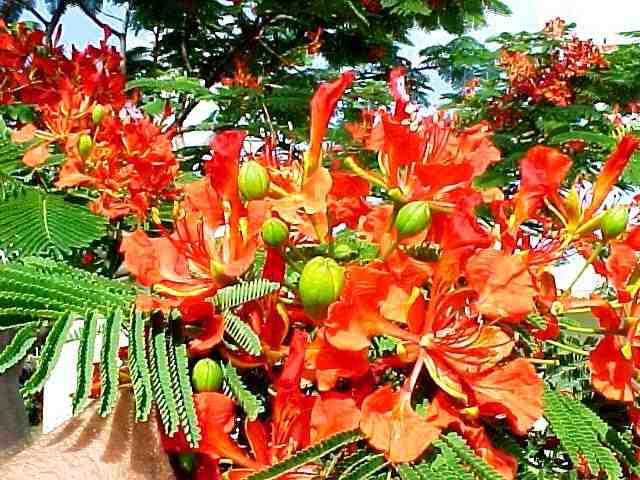
Delonix regia. Royal poinciana. Photo by the author exclusively for Bermuda Online.
Dendrobium. (Spray orchid). Pots only. One of the plants imported by the Bermuda Orchid Society
Dianthus
Diospyros kaki. Persimmon.
Diplazium laffanianum. Governor Laffan's Ferns. Endemic, most threatened, one of the 19 fern species native to Bermuda, with 3 of them endemic, Maiden Hair; Bermuda Shield Fern and Governor Laffan. In Britton's book "Flora of Bermuda" it was first described by J. G. Baker in the Gardener's Chronicle 51:673 of 1882 from a living plant sent by Governor Laffan to the Royal Botanic Gardens, Kew, in 1880 and a dried specimen contributed by Governor Lefroy in 1874. It was found in caves and crevices between Harrington Sound and Castle Harbour up until 1905 and believed to have died out. But five were discovered, first by the former Superintendent of the Botanical Gardens in 1967, then forgotten, then again by Tulo Valley Nursery staff in early 2002 at the old Arrowroot Factory at the Bermuda Botanical Gardens when clearing for Masterworks Foundation.
Dockyard Lime. First brought to Bermuda by settlers. It was used as rent payment to landlords and exported to North America. The juice can be used to keep mosquitoes away. Jams and jellies were also made from it. The fruits contain pectin which is used today in some parts of the world in anti-diarrhea medicines.
Dodonaea viscosa. Jamaica dogwood. Native. Hopbush elsewhere. An evergreen shrub. Flowers in spring and summer. Seem mostly on coastal hillsides. Not like the North American dogwood (tree).
Dracaena draco. Dragon Tree. Native of Canary Islands. Also known as the dragon's blood tree. Only a few are known to exist here, such as outside the Crawl Post Office and in the Orchid and Fern Collection of the Bermuda Botanical Gardens.
![]()
Eichornia crassipes. Water Hyacinth, Water Orchid. A pretty aquatic, native to Tropical America, common in Devonshire and Pembroke marshes. Can be a beautiful ornamental but if discarded into one of the Island's ditches, ponds or marshes it is hugely invasive.
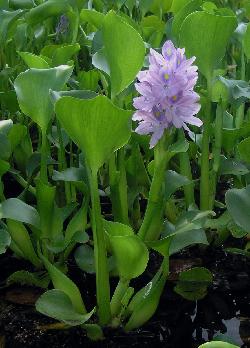
Water hyacinth
Elaeagnus macrophylla (Oleaster or Silverberry).
Elder. Elderberry. Caprifoliaceae, or honeysuckle family. A small tree with smooth grey bark or a thornless shrub. The three species here are the American elder (Sambucus cadadensis), native to Eastern North America; Sambucus nigra, a native of Europe; and Sambucus pubens, the American Red elder or Stinking elder. It does not fruit well in Bermuda. Flowers are edible.
Enterolobium cyclocarpum. Elephant's Ear. One was planted in the Bermuda Perfumery Gardens.
Epipremnum aureum. Pothos vine. Common house plant. When planted outside climbs into trees and hedgerows in a very invasive way. When young, the leaves are small. When mature, the leaves are elephant's ear-size. Leaves are variegated and become a blanket of green and white foliage. It develops stout stems several inches in diameter that cling to, and clamber up, trees or poles, growing leaves more than a foot long. See examples of pothos vines along Orange Valley and Parson's Roads, and in lots of other areas throughout the island. These vines cover large areas of underbrush or vigorously climb up a tree.
Erica abietina. Honeysuckle heath. Originally from South Africa. Hugely prolific in Bermuda, especially in red/orange. Makes a lovely hedge.
Erigeron darrellianus. Darrell’s Fleabane.
Eriobotrya japonica. Loquat. Introduced from Japan by Governor Reid in 1850 as a fruit crop long after it was - and still is - widely cultivated in Southern Europe as a fruit tree and ornamental. Imported to get local birds to stop eating expensive Bermuda citrus. A native of China. It thrives in sheltered areas, so much so it is wild in places. Nutritional value is significant, super-rich in vitamin A (beta-carotene) with a decent amount of minerals. A good source of manganese. The yellow-orange plum-like fruit 30-66 mm in size ripens in the late winter or early spring. They are edible, tart when yellow, sweet and light orange-colored when ripe, resembling a small apricot. Delicious stewed, fresh or preserved, as a relish or liqueur. Loquat liqueur is a smooth but potent, using gin, vodka or rum as the spirit base. Loquat cake is unusual. Loquat chutney is a condiment for cold meats. Loquat jam and ginger jam are delicious on toast or bread or mingled with peanut butter. Loquat pies make good eating. See Loquat Lane off Harrington Hundreds Road in Smith's Parish.
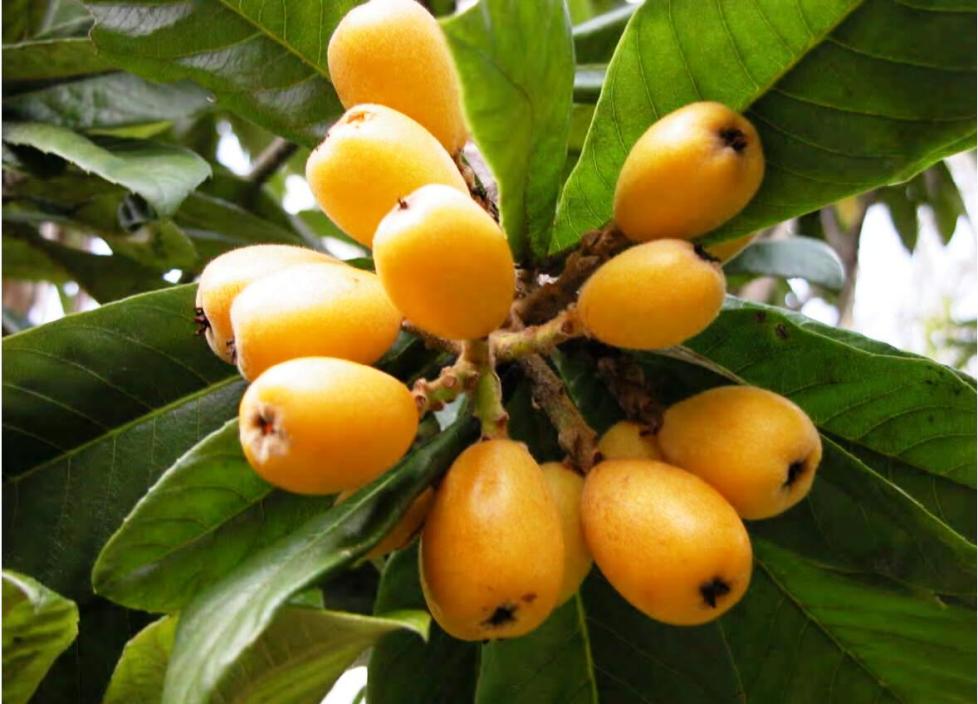
Loquats are common in Bermuda. Photo by the author exclusively for Bermuda Online.
Erythrina berteroana. Mother Tree. Not common.
Erythrina corallodendrum. Sword tree. Also known as the coral tree or coronation tree, planted for the coronation of King George V and Queen Mary in 1911. It was introduced from Barbados by R. R. Darrell in 1825.
Erythrina lysistemon. Cry Baby Tree. Not common.
Erythrina variegate, Coral Tree. Belongs to the Leguminosae (Pea and Bean) family, and is native to the Philippine Island and Indonesia. It is also known as the Lenten tree or Tiger Claw. This ornamental, deciduous tree has a smooth bark streaked vertical lines of green, buff, grey, and white. It bears brilliant orange-red flowers after losing its leaves and is one of several types of sword tree grown in Bermuda; they all have spiny stems and compound leaves made up of three leaflets. The scientific name comes from The Greek erythro for red.
Eucalyptus. Native of Australia or Tasmania or Malaysia. Introduced before 1877. Types growing here include the Murray red gum tree, Australian blue gum tree, swamp mahogany tree, red mahogany tree (king eucalyptus or red Australian gum tree), white gum tree, silver dollar gum tree (red box-tree) and Sidney blue gum tree (narrow-leafed Australian gum). A potential invasive, a cousin of the Surinam Cherry. Many other plants do not do well near them. They have a unique fragrance. Some can grow very tall.
Eugenia axillaris. White Stopper. Native shrub.
Eugenia uniflora. Surinam Cherry. Native. Technically a tree but most often seen as a hedge, useful but highly invasive. Originally from Surinam and region of South America it bears a small fruit like a miniature pumpkin. It has no resemblance in shape or taste to a North American or European cherry. Green at first, it turns yellow, then orange and finally red when ripe. In several varieties, one has almost black fruit. Home-made jams and jellies are made from it. With its density, it can affect light levels and change the nature of an area. Also common in Hawaii.
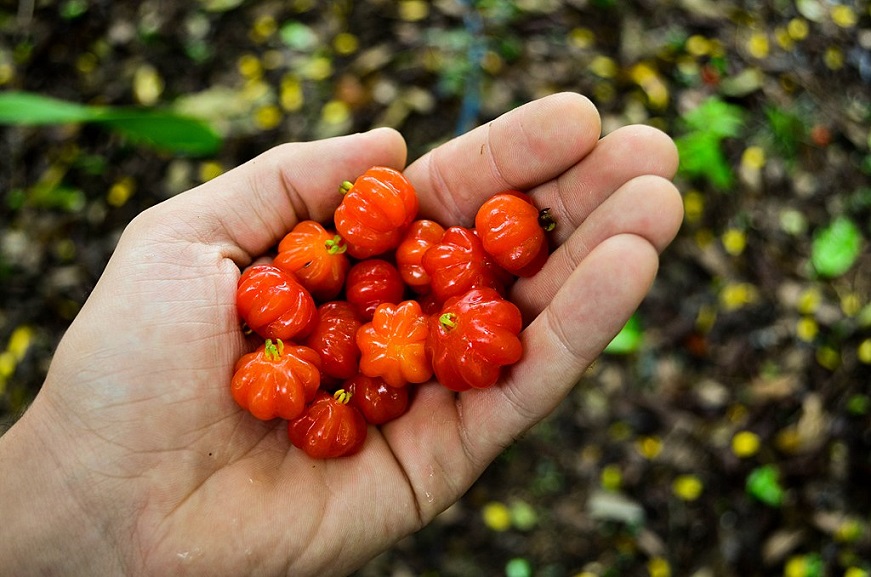
Eupatorium riparium. A native of South America. One of several types found in Bermuda.
Euphoria longan. A fruit native to India and Southern China, eaten straight from the tree, also good in a liqueur. Experimental specimens on the Botanical Gardens.
![]()
Feijoa sellowiana. Myrtaceae. Myrtle family. Pineapple guava or feijoa. Ornamental but with edible fruit. First imported in about 1925. Grows to about 18 feet. Can flavor ice cream.
Fennel. Non-endemic, invasive.
Ferns. There are several endemic ferns. See under "maidenhair."
Ficus benghalensis. Ban Yan Tree. From India and Ceylon (Sri Lanka). Also known as Indian fig tree or Indian banyan. There is a huge one in the Botanical Gardens near the road running to the offices from the South Road.
Ficus pumila. Creeping Fig. Also known as Climbing Fig and Creeping rubber plant. Native of eastern Asia. Not edible.
Ficus religiosa. Peepul. Mulberry family. Also bo tree or sacred fig. One of about 800 types of fig trees. Probably introduced after 1918. Only one specimen is known, in the Bermuda Botanical Gardens. Other more common fig trees include the edible fig and creeping fig.
Ficus retusa. Indian Laurel. Invasive and dangerous. It will crack a house, its walls and water tank. Its roots are the prime food source for the invasive starling, which spreads its seeds throughout Bermuda.
Fiscus elastica. Rubber tree, native of India and Far East. First introduced to Bermuda by Governor Turner's wife in 1826. A famous one, planted by Perot in 1847, is at Par-la-Ville, Hamilton, near the Bermuda National Library. Another is outside "Greymoss" on Flatt's Hill, Smith's Parish.
Floritam. An improved St. Augustine grass.
Forestiera. Forestiera segregata. Native shrub.
Forget-me-not
Freesia (wild and cultivated, usually in April and May). Naturalized, they are absolutely stunning. Worldwide, species are
Not all are yet known to be found in Bermuda. Of those that are, some are large, others are small. They usually flower in February and continue through until late March and beyond. Some locals have them in their lawns, growing wild, and will not cut the grass because it will destroy them until next year. They are so fragrant! Many gardens have them, in many different colors. In the 1980s John Lennon and his wife Yoko Ono stayed in Bermuda, rented a house in Fairylands, wrote some new songs and named what tragically became his final solo album ‘Double Fantasy’ after the Bermuda-grown Double Fantasy freesia flower he said he viewed in the Botanical Gardens. But there is some doubt about this as it was the wrong season for the flower during his visit, double fantasy freesias were once grown only in Holland and are so rare now they can't be seen. It is possible that what Lennon saw was instead a Double Fantasy hibiscus.
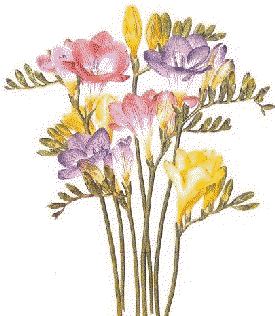
Freesias
Fuchsia
Furcraea foetida. Wild sisal or Mauritius hemp or green aloe. Closely related and similar in appearance to the century plant. With strong scented greenish white flowers.
![]()
Gaillardia (blanket flower). Grows wild in coastal areas.
Galphimia glauca. Cloth of Gold. Sense upright shrub up to 6 feet, small orange flowers in clusters.
Gardenia thunbergia. Gardenia. Not common.
Garlic. Herb. Good natural insecticide plant.
Gazania uniflora. Gazania. A groundcover with a nice daisy-like flower that withstands wind and salt very well here. Tolerant of poor soil and excellent ground cover. Native of South Africa.
Geranium. Can grow wild.
Ginger
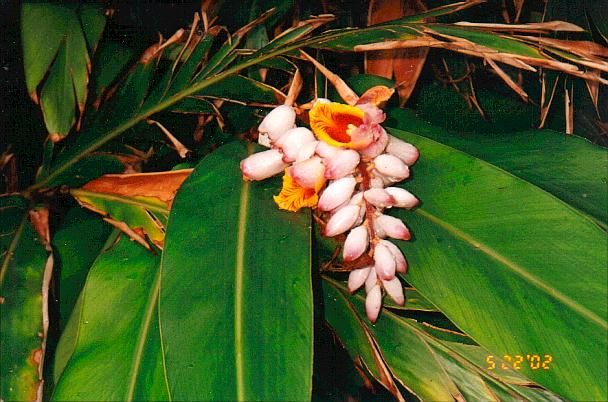
Photo by the author exclusively for Bermuda Online.
Ginkgo. (Ginkgo biloba). Chinese for "silver apricot." Introduced to Bermuda before 1914 from eastern China. A tall deciduous tree, with the males popular in North America as a street tree. Several are in the Bermuda Botanical Gardens in the Camden area and one is on the north side of the Cabinet Building in Hamilton.
Gladiola. One type grows wild as Bermuda gladiolus. Others are common as corn flag or sword lily. Imported to Bermuda from Cape of Good Hope in 1874. Many different colors.
Globba winitti. From Thailand.
Globe amaranth
Golden Mimosa. Acacia baleyana.
Governor Laffan’s fern. Recently re-introduced. Last seen growing in Bermuda in 1905 and efforts to reestablish the plant in 1960 failed. But now, thanks to a partnership between conservation experts on the Island and the Henry Doorly Zoo in Omaha, there is a chance the fern could make a comeback from the brink of extinction in Bermuda. Between November 24, 2014, and March 4, 2015, 41 Governor Laffan’s fern were planted at three sites in the Walsingham Nature Reserve. Additionally, in January 2015, eight ferns were placed in the Bermuda Audubon Society’s nature reserve at Sear’s Cave at Walsingham, Hamilton Parish. This was the first attempt at reintroduction using the plants produced by Omaha Zoo. One of the Omaha plants was a total failure, but at least some of the ferns survived at the other three. In November 2015 more Governor Laffan’s ferns arrived from Omaha. The ferns experimented with to grow in pots and to get them to successfully produce roots. Great care has been taken to recover this fern species. Like most endemic plant species, it is slow-growing and there is no historical data on where and how this plant was growing in the wild.
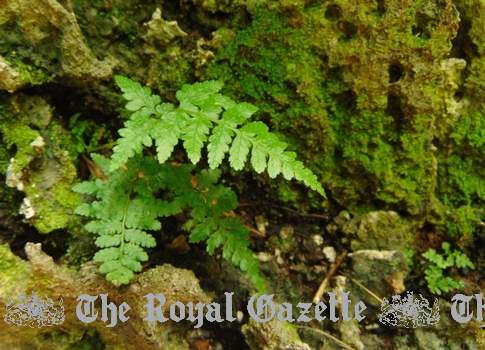
Governor Laffan fern
Graminae. Burr grass or Crab Grass.
Guajacum officinale. Lignum Vitae. National flower of Jamaica. Native to West Indies. Introduced. Grows but rare in Bermuda.
Guava. Grows in some gardens.
Gypsophila.
![]()
Hawaiian Pink Banana. Musa sp.
Hibiscus rosa sinensis. Hibiscus. From China. Considered wrongly by some visitors to be an endemic Bermuda flower. Hugely prolific, seen as a hedge or bush. There are many varieties including red, yellow and white. Some flower all year.
Photo by the author exclusively for Bermuda Online.
Hibiscus flowers in Bermuda. Photos by the author exclusively for Bermuda Online.
Homalocladium platycladium. Centipede plant. Also known as tape or tapeworm plant and ribbon bush. A native of Solomon Islands. In Bermuda since at least 1883. Can grow to 10-12 feet with tiny white flowers. Has a spicy scent. Only known specimen is at the Botanical Gardens.
Hymenaea coubaril. Amber Tree. West Indian locust. Not common now but at one point there were several, including one under which Methodist missionaries preached in a street called Locust Lane, Devonshire.
Hymenocallis sp. Spider lily. Thrives in Bermuda, often in salt-exposed locations. Different types are Hymenocallis declinata, native of the West Indies, common in Bermuda and Hymenocallis littoralis, native of tropical America.
![]()
Ilex vomitoria. Bermuda Holly. Both a tree and a bush. It was introduced to Bermuda from Virginia in the 18th century. Once it became naturalized it was quite prolific and used to thrive in the central parishes but is now rare. Two of the few places are Smith's Parish - check the northern side of the North Shore Road overlooking Gibbet's Island. On the southern side of the road is a residence called Holly Hill after the holly. Nearby is Holly Lane. And North Shore, Hamilton Parish near the Railway Trail. Also, you may see it in certain gardens, at certain times of the year.
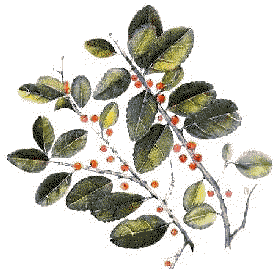
Bermuda holly
Impatiens. Good nectar plant for butterflies.
Ipomoea indica. Morning Glory. Of eleven species found here, three are native. This rampant vine is wild, will overgrow everything and can be an invasive nuisance. Often known as bluebell (not to be confused with the bluebell of Europe), it flowers all year, including along roads and cliffs. Has showy, trumpet-shaped blue to lilac blooms. A Devonshire Parish road, Morning Glory Drive, is named after it.
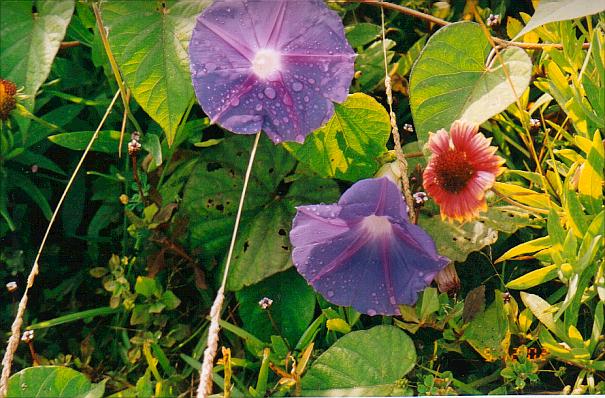
Photo by the author exclusively for Bermuda Online. Taken just after a shower of rain
Ixora coccinea. Flame of the Woods. A dense shrub reaching five feet. Flowers are in dense heads for inches across, salmon-red.
![]()
Jacaranda. Some flower twice a year.
Jamaica Dogwood. Dodonaea jamaicensis.
Jatropha hastata. Good nectar plant for butterflies. Also for sheltering and pupating butterflies.
Jonquil. See Narcissus.
Juniperus bermudiana. Bermuda Cedar. Endemic, a species of juniper, with dense, blue-green foliage. The leaves are scale-like, overlapping one another, with berries that turn a dark purple. The wood used for shipbuilding - in the 1700s and 1800s - houses, furniture and fuel. From 1943 (until the late 1950s) scale insects attacked and killed most of them. In 1949, the Bermuda Government constructed a laboratory at the Agricultural Station (now Botanical Gardens) to house experts brought in from the Imperial Institute of Biological Control. The work led to establishment of the Parks division of the Government in 1956.
Juniperus chinensis. Torulosa. From East Asia.
Justica betonica. White Shrimp Plant. Bushy shrub with upright spikes of snowy white bracts. Matire plant can reach over 3 feet.
Justicia brandegeana. Shrimp plant, shrimp bush, false hop. Introduced after 1918. Attracts hummingbirds. Named after Scottish gardener James Justice.
Shrimp in Bermuda. Photo by author exclusively for Bermuda Online
Justica betonica. White shrimp plant. Bushy shrub with upright spikes of snowy white bracts. Can grow to over three feet high.
![]()
Kalanchoe pinnata. Floppers. A succulent, common. Introduced either by a Captain Stowe in 1813 or in a letter. Allegedly a "good luck" leaf.
Kigelia pinnata. Sausage tree. Native of tropical West Africa. Several locally. Pollination thought to be done by bats.
![]()
Lagerstroemia Indica. Crape myrtle. Known locally as Queen of Shrubs. Good choice for Bermuda. Native of China. believed brought to Bermuda by Captain J. Austin, RN. Summer flowering, showy flowers.
Lantana camara. Yellow sage or Lantana. Good nectar plant for butterflies. Mainstay of many Bermuda gardens. Colorful display of small flowers one and a half inches across range from creamy white and yellow ro bright orange and vibrant reds. Hairy shrub reaches four feet. Locals once used it to clean their teeth.

Lapeirousia laxa. Pink Bermudiana. Also known as Star of the Veldt. From South Africa. A pretty weed.
Larkspur.
Lemon tree
Leucaena leucocephala. Jumbie bean.
Laurus nobilis. Laurel. Also known as bay or sweet bay. An evergreen that can grow to 40 feet. The leaf is used in flavoring.
Lathyrus
Leucaena leucocephala. Miracle Tree or Jumbi Bean.
Ligustrum japonicum. Japanese Privet. Grows well here when conditions are right.
Ligustrum lucudum. Glossy Privet, another species.
Lilium longiflorum eximum. Bermuda Easter Lily. Originally imported from and a native of the Ryukyu Islands of Japan. Japan was the first to dominate the market. Its lily-giving was a firm tradition. Now one of Bermuda's most famous flowers. Most common are the fragrant trumpet-shaped lilies in late March or April. When General and Mrs. Russell Hastings and their family lived at "Soncy" in Bermuda in the late 1800s, they prospered from the General’s venture into growing and exporting the bulbs of this distinctive, pure white Easter lily. In the late 1800s lily bulbs were an important agricultural export but disease and other problems halted overseas trade in 1899. In the USA, Louis Houghton, a World War I soldier veteran, began the popularity in the USA of the Bermuda Easter lily. In 1919 he brought a suitcase of hybrid lily bulbs from Bermuda to the southern coast of Oregon and gave them to family and friends to plant. The climate there was ideal for growing the lily and they became hugely popular. Elsewhere in the USA, there was an attempt to revive the once-flourishing trade from 1922 with the variety "Howardii" - which remained popular in Bermuda but it did not last long in the USA. By 1945, more than 1,200 growers from the west coast of the USA were producing their own bulbs in the thousands, then hundreds of thousands, for the commercial market. Nowadays, Today, a concentrated group of growers, mostly from along the California-Oregon border, have created an area known as the "Easter Lily Capital of the World." There, they produce 95 percent of all bulbs grown in the world for the potted Easter lily market. In 2002, more than 11 million bulbs were shipped to commercial greenhouses throughout the USA and Canada, mostly in the two weeks before Easter.

Lilium longiflorum eximum. Bermuda Easter Lilies. Photo by author exclusively for Bermuda Online
Lily turf. A common ground cover.
Lime. See Citrus Aurantifolia, above.
Liriope muscari. Lilyturf, from China and Japan.
Livistona chinensis. Chinese Fan Palm. From South China. Nice plant but some consider it highly invasive and thus maligned.
Lobster Claw. Heliconia wagneriana.
Heliconia (Lobster claw). Photo by author exclusively for Bermuda Online
Logwood tree (Haematoxylum campechianum). Also known as bloodwood tree and campeachy wood. In the Leguminosae family. Only 2 are known in Bermuda, at the Botanical Gardens. A native of Mexico.
Love Tree. Bauhinia alba. Not common.
![]()
Macadamia integrifolia. Grows well here but seeds are not harvested.
Madagascar olive. Noronhia emarginata, after the Spanish naturalist and traveler Fernando de Noronha who died in 1787. A small, attractive evergreen tree widely planted, but highly aggressive and invasive. They can stand wind and salt spray.
Malpighia coccigera. Singapore Holly. Shrub. Spreads to four feet.
Manilkara zapotilla. Chewing Gum Tree. Not common but a few years ago, one was planted in the Bermuda Perfumery Gardens.
Mandevilla. Some splendid specimens have been seen growing in local gardens.
Mangroves. Bermuda’s sandy beaches once supported large colonies of nesting sea turtles. These were lost to over-harvesting. A “mangrove” is the collective term for all the trees that make up an inter-tidal forest, the largest of which in Bermuda is in Hungry Bay. Much of the coastal “mangrove” seen around Bermuda are just scattered trees, remnants of larger forests that have been reduced dramatically since the time of colonization in 1609, primarily as the result of our intensive development of the coastal zone. Only two mangrove tree species are found in Bermuda, the Red Mangrove (Rhizophora mangal) and the Black Mangrove (Avicennia germinans), where the red mangrove occupies the seaward edge of a forest because the extensive “prop” roots of the tree can support it during intense storms and hurricanes. The black mangrove lacks these prop roots and resides behind the protective red mangroves at the back of the forest. Mangroves are trees and shrubs that grow along a saline strip along the coast. They form an important coastal protective barrier against the impact of tropical storms and hurricanes. Bermuda's mangroves are also a rich source of biodiversity and provide an important nursery for small fish. Their aerial roots act as props to give them plenty of stability. They are seldom torn up by storms or gales and are vital to our coastlines because they stop the shores from eroding. They have adapted themselves to living in salt water. Both types of mangroves have waxy leaves to conserve fresh water. For the survival of the species, their seeds start growing on the parent tree to ensure they are not lost in the mud at the foot of the tree. Sprouting seeds fall into the water below and find where they can establish roots of their own. Mangrove areas provide nurseries for fish and crabs including marine and land hermit crabs, land crabs and mangrove crabs, and habitats for a variety of wild fauna. The coffee bean snail is another well-known resident. Young barracuda, snappers and grunts live in these areas, as do adult damselfish, bream, wrasses and parrotfish. The water is calm and less salty than in the ocean and mangrove leaves provide a good supply of food. In Bermuda mangrove areas are nesting birds such as herons and egrets, under their marine forest canopy. Mangroves act as sand and soil traps, keeping waters clear and protecting coastlines during storms. Aimed at the most delicate of ecosystems, the Ministry of the Environment and Sports has launched a Mangrove Conservation and Restoration Plan in recent years to protect existing sites and initiate new mangroves to strengthen the marine environment. The National Nature Preserve at Cooper's Island has a mangrove reserve. Mangroves in Bermuda are protected under the Protected Species Act 2003 due to their value for habitat and ability to mitigate coastal erosion and Hungry Bay is a designated RAMSAR site, a “Wetland of International Importance.”
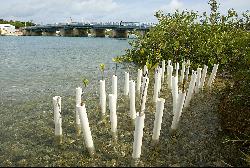
Mangroves in Bermuda
Magnolia grandiflora. Southern Magnolia. Introduced to Bermuda by 1875 when it was planted at Mount Langton (now Government House). It is a native of from North Carolina to Texas. It flowers in June and the large, fragrant creamy-white flowers are magnificent. Trees can be seen at the Bermuda Botanical Gardens, Bermuda Perfumery and on the left, walking up Sleepy Hollow Drive on Hamilton Parish. They can grow to 100 feet high.
Mahoe. Three types locally, Hibiscus tiliaceus - also sea hibiscus - Thespesia populnea - seaside mahoe or portia tree; and H. elatus - blue mahoe or Cuban bast, the national tree of Jamaica and a good timber tree. Evergreen shrubs or small trees.
Malpighia coccigera. Singapore Holly. Shrub. With distinctive small shiny leaves and pale pink flowers about 0.75 inches in diameter which, when they die are replaced by red berries. Spreads up to 4 feet.
Marigold. Good nectar plant for butterflies. Good natural insecticide plant.
Melia azederach. Sacred Lilac. Not common. Often called Pride of India or Chinaberry. Lovely tree. Introduced from South Carolina in 1780.
Milk Bush Pencil Tree (Euphorbia tirucalli).
Milkweed. Good nectar plant for butterflies. Also a good host plant for caterpillars and their butterflies (Monarch). Two types in Bermuda, the red and orange blood flower or wild ipecac (Asclepias currasavica) which grows about three feet high; and the taller, white-flowered tennis ball plant (Asclepias physocarpa) which grows to five to 6 feet tall.
Mimosa pudica. A shrubby, widespread weed. Leaves close within seconds of being touched.
Mint. Herb. Good natural insecticide plant.
Mock Orange (Murraya exotica). Ornamental. Although a rampant grower, it does not invade areas outside its domain.
Monkey's Comb. Apeiba aspera.
Mora (Murraya paniculata). Also known as Martinique laurel, orange jasmine, satinwood, cosmetic-bark tree, Chinese box and mock orange. Introduced to Bermuda before 1918. Ever-green foliage, fragrant flowers and pretty red fruit.
Mulberry. Three types, Morus rubra, red, native, quite rare, found growing by Bermuda's earliest settlers; Morus nigra, black; and Morus alba, white. The latter two often mixed with the first are not native and not common but grows well in Bermuda. In 1610 an important experimental collection of seeds was brought to Bermuda in 16010 by a Frenchman by order of King James 1 of England. He ordered mulberries to be grown in the islands with the silk trade in mind. In 1627, an Act was passed requiring 50 mulberries to be planted on every share of land for three successive years. Rich in vitamin C, the fruits are eaten raw or cooked to make jams and wine.
Musa paradisiaca. Banana. Grows well in Bermuda.
Myrica cenifera. Wax myrtle. Native shrub.
![]()
Naked Tree. Erythrina fusca.
Narcissus. family Amaryllidaceae. Includes daffodils and Jonquils. Imported to Bermuda originally, but do well here. Natives of Europe, North Africa and western Asia.
Nasturtium bauhinia. Bauhinia punctata. A spreading deciduous, woody shrub that can achieve a height of 10 feet. Colorful blooms flourish in the summer months, range from peach to deep redand are about 3 inches across.
Nerium oleander. Oleander. Introduced to Bermuda in 1790. Now one of Bermuda's most famous flowers but not exclusive to Bermuda by any means. Also common now in places as far north as London. A native of the Orient, an evergreen shrub. It makes excellent hedges or bushes. It has clusters of flowers all year, especially in spring and summer. Pink flowers are the most common but they also come in white and red. But beauty is misleading as they are poisonous. An outbreak of oleander scale in Bermuda in 1917 led to legislation that in 1923 provided for a plant pathology section of the Bermuda Government.
New Caledonia Pine (Araucaria columnaris). A native of New Caledonia and the New Hebrides. Similar to the Norfolk Island Pine until they are at least 25 years old. One of the most primitive living conifers.
New Guinea Creeper. Mucuna bennetti. Not common.
New Zealand Fern Tree
Nicandra physalodes. Apple of Peru. Shoo-fly. Native of Peru.
Nicotiana
Night Blooming Cereus. Common. In the Cactaceae or cactus family.
Nephrolepis cordifolia. Sword Fern. A ground cover, growing in shade.
![]()
Odontonema strictum. Odontonema. In the Acanthaceae family. An evergreen shrub with bright red flowers, growing upright to 6 feet. It has medium green leaves. Each tubular flower is about 1 inch long. Good for attracting hummingbirds.
Oenothera humifusa. Seaside evening primrose. Native coastal. Probably brought by birds.
Oenothera laciniata. Sinuate-leaved evening primrose. Native coastal. Probably brought by birds.
Olea europa. Olivewood bark. A native of the Mediterranean, introduced to North America in the 1500s, it was found growing in Bermuda by the first settlers. It is quite common but olive oil is not produced locally.
Oncidium. (Dancing lady orchid). Pots only. One of the plants imported by the Bermuda Orchid Society
Opuntia dillenii. Prickly Pear. Grows well in Bermuda.
Orange tree. Two types can grow well here, the sour orange and much larger Washington Naval.
Ophiopogon japonicus. Mondo Grass, from Japan and Korea.
Orchid. There are many different varieties available, all imported. Most will not grow successfully in the ground, only in pots. The Bermuda Government import duty rate on orchids is 33.35 percent of wholesale cost, highest in the world. In the USA, Canada and United Kingdom, there is no import duty. The Bermuda Orchid Society is an affiliate of the American Orchid Society.
Oxalis pes-caprae. Bermuda buttercup. Yellow flower. Generally described as a Perennial Forb or herb. A Dicot (dicotyledon) not native to the USA, said to have come from Bermuda, hence the name. Common in the deep south of the USA., also prolific in Menorca.
Bermuda Buttercup
![]()
Pandanus utilis. Screw Pine. Also known as screw palm. The edible fruit resembles a deeply pitted pineapple. Common in Bermuda, plus elsewhere in temperate and sub-tropical climates, but a native of Madagascar. It has a trunk with many branches. There is a fine specimen in the Bermuda Botanical Garden.
Pansy. Not a native but grows well.
Paphiopedilum. Slipper orchid. Pots only. One of the plants imported by the Bermuda Orchid Society
Passifloraceae. Passion Flower. Locally the Passiflora incarnata, Passiflora caerulea (most common in Bermuda, used to make perfume), granadilla P. edulis, Passiflora lingularis and Passiflora quadrangularis. Passiflora caerulea has leaves with 5 or 7 lobes and fragrant flowers with pinkish petals and a white, blue and purple crown. The egg-shaped fruits are yellow. A tendril-climbing evergreen the blooms are produced profusely from spring to autumn. They thrive best in a sunny position and need protection from wind. There are over 460 known species of Passiflora. The book, Passion Flowers (2nd Edition), by John Vanderplantk, MIT Press, Cambridge, USA, 1996 describes 150 different species and has over 120 colored photos documenting the various species. Passiflora lingularis is not common in Bermuda but one was planted in the Bermuda Perfumery Gardens. None of these varieties are native of Bermuda but the Americas. Naturalized, the name comes from early Spanish and Portuguese priests who associated it with Christ's Passion. Legend has it that in 1620 a Jesuit Priest came across the plant we now know as passion flower. Enthralled with its beauty, that night he had a vision likening its floral parts to the elements of the Crucifixion or Passion of Christ. They include 10 points in the star shape (five petals, five sepals) representing apostles present at the Crucifixion (omitting Peter and Judas); 72 filaments for the traditional number of thorns in the crown of Christ; 5 anthers corresponding to his wounds; 3 styles with rounded stigmas representing the three nails; and coiling tendrils for the whips. The flowers have a delicate scent and last for one day only. Care should be taken as it te passion flower is a good host plant for caterpillars and their butterflies, especially the Gulf Fritillary.
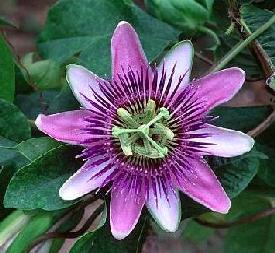
Passion flower, photo by author
Peach (Prunus Persica). A native of China. Spanish explorers brought it to the New World. It is thought to have been introduced to Bermuda in 1790 by Governor Hamilton. The most important of the deciduous tree fruits of the apple and pear (neither of which grow in Bermuda). Peaches were cultivated in the late 1800s and early 1900s, until the advent of the Mediterranean fruit fly. A number of sheltered gardens have them. They are lovely but small by North American and European standards.
Pentas. Good nectar plant for butterflies.
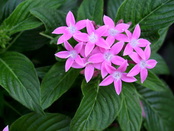
Pereskia aculeata. Barbados gooseberry. In the Cactaceae or cactus family, with leaves. Also known as the lemon vine and leaf cactus. Not common. With creamy white flowers each nearly two inches across, lemon scented. sweet and pungent, attractive to bees. There are spherical orange colored fruit, good for jam, fresh or stewed.
Persea americana. Avocado. Can be prolific in certain sheltered areas in Bermuda. A tree native to Central Mexico, classified in the flowering plant family Lauraceae along with cinnamon, camphor and bay laurel. Avocado or alligator pear also refers to the fruit, botanically a large berry that contains a single seed. Bermuda has two types, the much smaller one in known as "alligator pear" because of its rough green skin. A grafted Bermuda one - referred to as an Avozilla - has smooth skin, can be round or typically avocado pear-shaped - will grow four times times as large as and at 3 lbs in wight is five times heavier than the typical variety. There are some huge grafted avocado trees, in Fairylands, Pembroke and elsewhere. They deliver tons of fruit to owners, some of whom who have many houses in Bermuda which they rent out. But a rental condition is that the owners not the renters are entitled to the avocado pears.
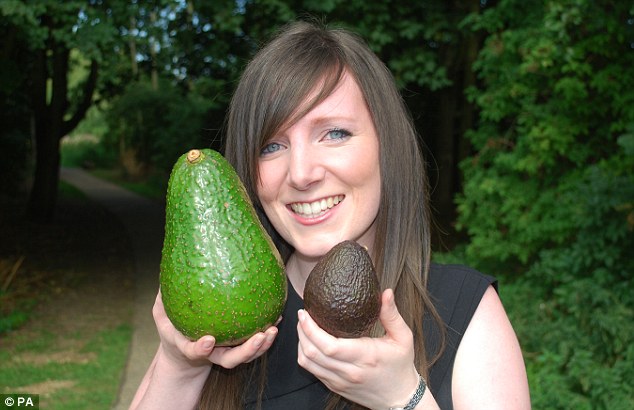
Avozilla
Avocados are a good source of fibre, potassium, and vitamins C, K, folate, and B6. Half an avocado has 160 calories, 15 grams of heart-healthy unsaturated fat, and only two grams saturated fat. One avocado contain most of your daily requirement for vitamin C and vitamin K. Sailors on route to the New World in the 16th century used avocado in place of butter. Male trees must be planted with female trees to bear fruit. Subject to attack by the Pink Mealybug. There are only a few such trees left in Bermuda and their fruit is never sold commercially. 99.99 percent of avocados bought for eating are imported. Bermuda imports more than two million avocados a year. There are local recipes for avocado soup and guacamole dip. Avocado pears are commercially valuable and are cultivated in tropical and Mediterranean climates throughout the world. They have a green-skinned, fleshy body that may be pear-shaped, egg-shaped, or spherical. Commercially, it ripens after harvesting. Trees are partially self-pollinating and often are propagated through grafting to maintain a predictable quality and quantity of the fruit.
Petunia
Phalaenopsis. Moth orchid. Pots only. One of the plants imported by the Bermuda Orchid Society
Phaseolus lignosus. Wild Bermuda Bean.
Phlox
Pimenta dioica. Allspice. With fragrant evergreen leaves when crushed
Pillow Tree. Ochroma lagopus.
Pimenta dioica. Allspice tree.
Pineapple. Imported then grown locally in pots by some. Takes about 9 months.
Pineapple Ginger. Tapeinochilus ananassae.
Pink Shower (Tebebuia rosea). Not common. One was planted in the Bermuda Perfumery Gardens.
Piper nigrum. Black Pepper. Not common.
Pistia stratiotes. Water Lettuce. Also known as shellflower. An aquatic plant often seeing growing in ponds and aquaria. Leaves are shell-shaped. Flowers are inconspicuous.
Pittosporum tobira. Excellent hedge plant and a small but lovely umbrella-shaped specimen tree if pruned carefully. A native of China and Japan. There are several different types, such as the Victorian box, P. undulatum with wavy-edged leaves and one with variegated leaves.
Plaintain. (Not the coarse banana). Native of Europe, where there are more than 200 types. Two grow in Bermuda, Plantago lanceolata, known as cat's cradle or rib-wort or rib-grass; and Plantago major, the larger and less common. In America, called "Englishman's foot." A good host plant for caterpillars and their butterflies (Bermuda Buckeye).
Platanaceae. Platinus. Deciduous tree with peeling bark. Native of North America.
Platanus X acerifolia. London Plane Tree. Not common, not suitable for most Bermuda gardens but some at Botanical Gardens and south side of Victoria Park.
Plumbago auriculata. Blue Plumbago. Shrub, with delicately colored blue and white flowers, rises to about 3 feet high, blooms from spring through summer.
Plumeria apocynaceae. Known locally as Frangipani. Small tree. Originally imported. Native of Hawaii where they make leis out of the petals, also Asia, West Indies 1000 miles to the south of Bermuda , Mexico and Panama. Naturalized now in many Bermuda gardens too, grows by planting a branch. The best-known species locally is P. alba, mostly creamy white with an orange yellow center. There is also Plumeria rubra, little smaller, with flowers from pale pink to deep rose.
Plumeria rubra. Also known as Frangipani. Grown as an ornamental tree throughout the Island, and belongs to the Apocynaceae (Dogbane) family. This small, deciduous tree is the perfect size for many Bermuda gardens, providing beauty and fragrance, as well as welcome shade in the summer. With branches that look like thick fingers, Frangipani is least attractive when its large, oval leaves fall in the winter. New leaves appear in the early summer and are soon followed by waxy flowers held in large clusters at the branch tips. The flowers, which resemble pinwheels, remain throughout the summer. Frangipani is native to Mexico and Panama, and the name Plumier, a French botanist who died in 1704.
Plumbago. Good nectar plant for butterflies.
Poinsettia. (Poinsettia pulcherrima). Often referred to in Bermuda as the Christmas Bush, Part of the Euphorbiaceae family. The common red variety can grow wild naturally. A native of Mexico (but in Bermuda it originally came from the USA, now it is grown locally. The plant flourished in an area of Southern Mexico known as Taxco del Alarcon. The Aztecs used the plant decorative purposes but also put the plant to practical use. They extracted a purplish dye for use in textiles and cosmetics from the plant’s bracts. The milky white sap, today called latex, was made into a preparation to treat fevers.The Aztecs called it Cuetlayochitl. Chile and Peru refer to it as the "Crown of the Andes." The outer leaves form the large red or white flower heads. A fresh poinsettia is one on which little or no yellow pollen is showing on the flower clusters in the center of the bracts. Not poisonous but oozing a milky sap. Every December, there is a beautiful selection on display in one of the outbuildings of the Bermuda Botanical Gardens. In Bermuda, it grows readily from cuttings and blooms but house plants should be placed in a sunny window away from warm or cold drafts from radiators, air registers or open doors and windows, in a temperature of 60 to 70F. High temperatures will shorten life. Water when soil is dry. Apply a house plant fertilizer once a month. The plant has a long and interesting history woven in a combination of legend and politics. It may have remained a regional plant for many years to come had it not been for the efforts of Joel Roberts Poinsett (1779-1851).
The son of a French physician, Poinsett was appointed as the first United States Ambassador to Mexico (1825-1829) by President Madison. Poinsett had attended medical school himself, but his real love in the scientific field was botany. (Mr. Poinsett later founded the institution which we know today as the Smithsonian Institution). Poinsett maintained his own hothouses on his Greenville, South Carolina plantations, and while visiting the Taxco area in 1828, he became enchanted by the brilliant red blooms he saw there. He immediately sent some of the plants back to South Carolina, where he began propagating the plants and sending them to friends and botanical gardens. Among the recipients of Poinsett's work was John Bartram of Philadelphia, who in turn gave the plant over to another friend, Robert Buist, a Pennsylvania nurseryman. Mr. Buist is thought to be the first person to have sold the plant under its botanical name, Euphorbia pulcherrima. It is thought to have become known by its more popular name of poinsettia around 1836, the origin of the name recognizing the man who first brought the plant to the United States. Congress honored Joel Poinsett by declaring December 12th as National Poinsettia Day which commemorates the date of his death in 1851. The day was meant to honor Poinsett and encourage people to enjoy the beauty of the popular holiday plant. The Poinsettia also gains its popularity with the legend of Pepita, a young girl with a gift for the Christ Child. She was a poor Mexican girl who had no gift to present the Christ Child at Christmas Eve Services.
As Pepita walked slowly to the chapel with her cousin Pedro, her heart was filled with sadness rather than joy. But her cousin said he was sure that even the most humble gift, if given in love, will be acceptable in His eyes. Not knowing what else to do, Pepita knelt by the roadside and gathered a handful of common weeds, fashioning them into a small bouquet. Looking at the scraggly bunch of weeds, she felt more saddened and embarrassed than ever by the humbleness of her offering. She fought back a tear as she entered the small village chapel. As she approached the altar, she remembered Pedro's kind words: "Even the most humble gift, if given in love, will be acceptable in His eyes." She felt her spirit lift as she knelt to lay the bouquet at the foot of the nativity scene. Suddenly, the bouquet of weeds burst into blooms of brilliant red, and all who saw them were certain that they had witnessed a Christmas miracle right before their eyes. From that day on, the bright red flowers were known as the Flores de Noche Buena, or Flowers of the Holy Night, for they bloomed each year during the Christmas season and thus, the legend of the poinsettia was born. The shape of the poinsettia flower and leaves are sometimes thought as a symbol of the Star of Bethlehem which led the Wise Men to Jesus. The red colored leaves symbolize the blood of Christ. The white leaves represent his purity. The Poinsettia is also the national emblem of Madagascar.

Poppy. Some full double poppies grow in some good sheltered gardens.
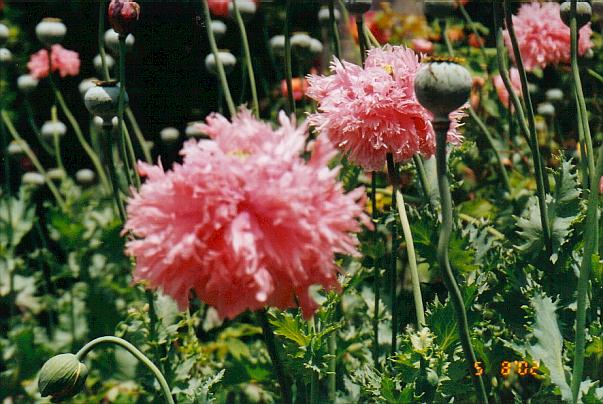
Photo by the author exclusively for Bermuda Online.
Pourouma cecropiifolia. Amazon Grape.
Pouteria campechiana. Canistel. Evergreen, rare locally, common in Florida, Cuba and elsewhere in Caribbean. Small, fragrant cream flowers with orange-yellow fruit, edible.
Prickly Pear Cactus. . In the Cactaceae or cactus family. Common, native.
Pride of India (Melia azederach). From South Asia. Introduced. A majestic tree in the landscape. The bark, flowers and foliage are nice.
Psidium guajava. Apple Guava. One is planted in Bermuda Perfumery Gardens.
Pueraria lobata. Kudzi. Extremely aggressive invasive that has grown in Bermuda for over 30 years and has spread alarmingly An eradication program began in March 2004 from public areas such as the Railway Trail.
Punica granatum. Pomegranate. From Spain, introduced very early from the UK and sent from Bermuda to Virginia with other fruits in 1621. Once prized as a fruit and to cure ailments. Fruits are sphere-shaped, red-brown and with a thick skin. Popular ornamental. Now naturalized.
Pueraria montana. Kudzu. Native of China and Japan. Introduced to Bermuda sometime before the 1970s. In Bermuda it can grow 12 inches a day. Extremely invasive and spreading rapidly.
Purple Crown. Petrea volubilis.
![]()
Rainbow Shower. Cassia grandis.
Rain Forest Lilac. (Gliricidia sepium). Not common. One was planted in the Bermuda Perfumery Gardens.
Rain Tree. Samanea saman. Not common.
Raphanus. Wild radish. Also known as jointed or white charlock. Can be seen flowing on roadsides. A native of Europe and Asia, it is a weed, but pretty. Two types are here. On one, the flowers are pale yellow, fading to white. On the other, they are pink or white.
Rhizophora mangle, or Red Mangrove, is a non-endemic native evergreen tree reaching up to 25 feet via numerous aerial roots from lower branches. It grows only in mud at the edge of salt lagoons and bays. It has pendulous fruits. With lots of aerial roots and root systems resembling eggs of gigantic spiders. Have air-breathing organs on their prop roots, which carry air to the roots in the salty mangrove swamps where the sediment is poor in oxygen. The prop roots excrete some of the salt the tree brings in. See more under Mangroves.
Rondeletia Odorata. Upright bushy shrub up to 6 feet, Flowers are small, orange in color and arranged in clusters.
Rudbeckia
Ruellia brittoniana. Weed, island-wide.
Russelia equisetiformis. Heath. Also known as the coral plant or fountain plant of fountain bush or honeysuckle. Neither a true heath nor true honeysuckle. In the figwort family. Native of Florida and West Indies. Grows all over Bermuda.
![]()
Sabal bermudana. Bermuda Palmetto. Endemic, the only native palm tree, a cabbage palm with a short stem and large leaves. Older specimens can be 30 feet high. Early settlers thatched their roofs with the leaves, fed berries to pigs and made Bibby, a very intoxicating drink, from the sap. In the 1700s, ladies hats were made from these leaves and were the height of fashion in London.

Sabal bermudana, Bermuda palmetto, above
Sage. Also known as Lantana. (Not the edible herb). Believed to have been introduced to Bermuda by Colonel Spofforth from the Bahamas before 1800 as firewood for poor people who could not afford cedar. The most common is the red sage, Lantana camara, with red and yellow flowers or other color varieties. A prickly sage is L. camera aculeata. It grows to several feet high and may be prickly. The flowers are clusters of florets in round-topped heads on strong stems. The fruit turns from green to black, looks like a blackberry but is poisonous. Leaves can cause a skin rash.
Saintpaulia (s. ionantha). African violet. Very popular locally, native of East Africa, herbaceous perennial, some with two-colored flowers. Can be propagated by leaf cuttings, grow best in light but not sunlight conditions.
Salpiglossis
Salvia officinalis. Garden sage. Good nectar plant for butterflies.
Salvinia. An aquatic fern.
Grows very quickly. Soon forms thick mats over the surface of ditches and ponds, smothering the pond, preventing sunlight from reaching down into the water, and making it difficult for birds and other wildlife to feed on the life in the water. Now chokes many ditches and ponds in Bermuda.Sandbox Tree (Hura crepitans). Do not stand underneath this tree to admire it, as the sap is caustic. There is one in the Somers Garden in St. George's.
Sanseveiria (Mother-in-law's Tongue or Snakeplant). One of the many not indigenous to Bermuda that can be integrated into the environment but they must monitored carefully because they can quickly become invasive pests.
Sasa sp. Dwarf bamboo. From East Asia.
Sea Island cotton. (Gossypium barbadense). Imported to Bermuda in the early 1600s and once planted extensively, once woven and dyed at Ireland Island, now purely an ornamental. None of its many products are harvested in Bermuda commercially. Specimens can be seen in the Bermuda Botanical Gardens east of the former Arrowroot Factory and near the St. George's Historical Society. Nice flowers.
Sea Grape. See Bay Grape and Coccoloba uvifera.
Seaside goldenrod. (Solidago sempervirens). Flowers every summer in coastal areas and is conspicuous with large bright yellow flower heads. It is the only one of 130 different types of goldenrod to grow in Bermuda. Good nectar plant for butterflies.
Seagrasses. Very important to the marine ecosystem. They link mangrove communities to coral reefs. The four species in Bermuda are Thalassia testudinum (turtle grass); Syringodium (manatee grass); Halodule wrightii (shoal grass, common) and Halophila decipiens (rare).
Schinus terebinthifolius. Brazilian or Mexican Red Pepper Tree. Bermuda gardeners view it as Public Enemy #1. Introduced as an ornamental, it has light green leaves and red stem. Birds love it and spread it easily but it is one of the most aggressive and invasive plants, often growing wild, with thousands of bright red seeds that take root anywhere. Their only use is as a decoration for Christmas instead of the now-rare Bermuda holly. It is extremely difficult to purge. Hurricane Fabian did so to some extent in late 2003. But it is extremely popular with local bees as a source of nectar in locally-produced honey. Despite being invasive when properly maintained it can be an attractive tree, especially in winter. In June 2019 the Bermuda Government eyed Florida as that US state state tested the use of insects to tackle Brazilian pepper trees. The invasive weed was introduced to both Bermuda and the United States as an ornamental plant, but is now considered a threat to biodiversity because of its fast growth and prolific seed production. Florida was considering introducing two “host specific” species of insect, yellow Brazilian pepper tree leaf-gallers and Brazilian pepper tree thrips, to tackle the problem. Both species, native to Brazil, feed and lay their eggs on Brazilian pepper trees, which inhibits their group and hinders the population. In previous studies, both insects largely avoided other plants even when there were no Brazilian pepper trees around. A spokeswoman for the Department of Environment and Natural Resources said results of the work being done in Florida would be monitored.
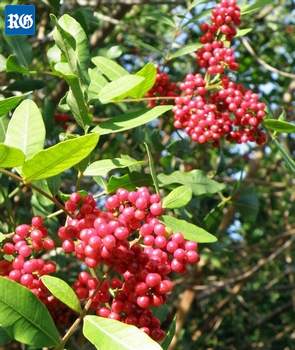
Brazilian Red Pepper
Solandra maxima. Golden Chalice flower. Found readily in some of Bermuda's better gardens.
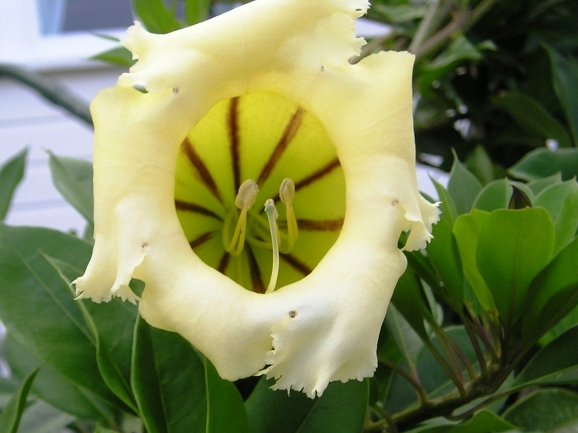
Solanum quitoensis. Apricot Tomato.
Solanum rantonnetii. Blue Potato Bush. Open shrub with colorful show of blue-purple flowers about one inch across. Can grow to six feet high.
Snapdragon Tree. Gmelina arboria. Not common.
Snowberry. Endemic. How it got the name of snow is a mystery as there is none in Bermuda.
Snow-on-the mountain
Sophora tomentosa. Coast sophora. Known elsewhere as silverbush. A tall shrub or small tree growing from 3-9 feet elsewhere but here as a shrub, with medium yellow flowers.
Southern Hackberry.
Spathiphyllum (Spathiphyllum sp). An attractive herbaceous evergreen best known as an indoor plant but does well outside in shaded areas. There are nearly 30 types. Natives of tropical America and Malaysia. Flowers are in a white spike.
Spider flower/cleome
Stachytarpheta jamaicensis. Jamaica vervain. Also known as Blue Flower. Weed.
Statice
Stephanotis. Very wind tolerant, with fragrant flowers.
Stenotaphrum secundatum. St. Augustine grass, referred to locally as Bermuda crabgrass or buffalo grass. Most common lawn grass in Bermuda because of its versatility as a good shade grass with excellent salt tolerance. It is also adapted to a wide range of soil types. St. Augustine has a fast growth rate, which allows it to recover quickly from damage. The rapid growth rate does however contribute to a buildup of plant matter called thatch. If watering and fertilization are mismanaged, this spongy mass must be removed periodically, with a rake, depending on the size of the area.
Stinging nettles. Very similar in size and shape to those in North America. Keep well clear of them.
Sugar cane. (Graminae). First brought here on the ship Edwin in 1616. Once, a great deal of sugar cane grown and sugar made, but this is not done commercially any longer. It is grown in only a few gardens with no industry involved. Here, it takes from 8 to 16 months to ripen. Unlike in Barbados and much of Caribbean 1,000 miles to the south, no rum from sugar cane is manufactured in Bermuda.
Surinam cherry. See Eugenia flora.
Sunflower (Hellanthus sp). With large, cheerful, yellow, flat flowers on a hairy stem 3-15 feet high. Common in many Bermuda gardens as H. annuus. Native of USA and New World.
Swan River Daisy (Brachycome iberidifolia). An annual from Australia, growing more than 12 inches tall.
Sweet William
![]()
Tabebuia chrysantha. Golden Goddess. Not common. One was planted in Bermuda Perfumery Gardens.
Tabebula pallida. Misleadingly called white cedar but not a cedar at all. Or otherwise a Cuban pink trumpet tree. Can grow to 60 feet. Introduced by the 1870s, native of Caribbean. Best-known examples are at the Botanical Gardens and Bermuda Perfumery.
Tamarind. Tamarindus Indica. A Bermuda area is named after it.
Tamarisk. Tamarix gallica. Originally from Southern Europe and Canary Islands. Seafaring and trade, an economic mainstay from mid 1600s to mid 1800s, facilitated widespread importation, planted to protect coastal roads from gales.
Taraxacum officinale. Dandelion. An all too hardy perennial found on lawns and golf courses throughout Bermuda, first recorded here in 1806.
Tea plant. A common ground cover.
Tecomaria capensis. Cape honeysuckle. From South Africa. Attractive, bushy erect shrub, prolific in Bermuda, with bright orange flowers that bloom from spring through autumn or fall. .Can grow up to 8 feet high.
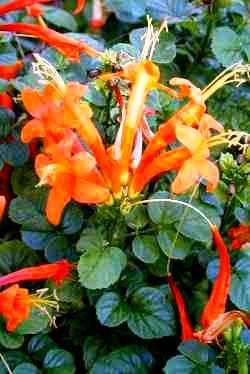
Cape honeysuckle
Terminalia catappa or Terminalia muelleri. West Indian almond. Native to Malaysia. Two types are found, can grow to 80 feet. Leaves turn red before they fall. Small white flowers. Green fruit, almond-shaped, yellow when ripe.
Thevetia peruviana. Spanish oleander. Introduced from Tropical America. An evergreen tree that can grow to 30 feet.
Tithonia (Tithonia rotundifolia). Tall Mexican sunflower. Also good for sheltering and pupating butterflies.
Thunbergia grandiflora. Skyflower. Also known as the Trumpet Vine, The Clock Vine and Bengal Trumpet Vine, The Clock Vine and Bengal Trumpet, and belongs to the Acanthaceae (Acanthus) family. White Sunflower, Thunbergia grandiflora var, alba, a woody, twining evergreen vine, is a rampant grower and produces lots of flowers. Native to India and naturalized in the tropics, White Skyflower was introduced to Bermuda and is becoming popular in gardens – like the Blue Skyflower, which is grown throughout the island and is happy hanging down over a wall or growing over a fence or a trellis. Skyflower is named for Karl P. Thunberg, a Swedish botanist and traveler in the late 1700s and early 1800s; Grandiflora, not surprisingly, means large flower.
Thunbergia mysorensis. A vine with a lovely flower, also introduced, native of India.
Tillandsia usneoides. Spanish Moss, also Old Man's Beard and Grey beard, used in the floral trade. A native from Florida to Texas, in Bermuda since at least 1918. This particular variety of Tillandsia is the only one with no roots, nor do the leaves form rosettes. Its gray and very slender stems and narrow leaves form strands that reach several feet in length. In Bermuda, the house Grey Moss, on Flatts Hill, Smith's Parish, is so-called because of it.
Torch Ginger. Nicolaia eliator. Not common.
Toxicodendron radicans. Poison ivy. Very prevalent and all should avoid it.
Turnera. Turnera ulmifolia. Native to tropical America and Bermuda. Brought here by birds or wind. Has a showy flower.
![]()
Vanda. Pots only. One of the plants imported by the Bermuda Orchid Society
Vibernum odoratissimum. Sweet Viburnum, from China and Japan.
Vigna Caracalla. Snail vine. Also known as Snail Flower or Corkscrew Flower. Introduced to Bermuda recently. But well-known since the 1700s in Europe and North America.
Vinca. Periwinkle. Good nectar plant for butterflies. Introduced.
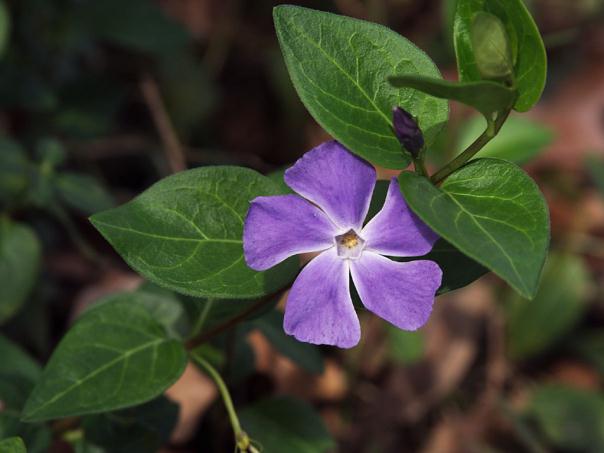
Photo by the author exclusively for Bermuda Online.
Viola. Introduced.
V. odorata. Garden, florist's or English, or sweet violet. Leaves and flowers of all violas are edible.
V. tricolor, or heartsease.
V. Cornuta. Horned viola.
V. X Wittrocklana. Pansy.
Vitaceae family. Grapes. First introduced in 1616, some time after Martha's Vineyard in MA, USA was so-named from the grapes growing there. Officially encouraged in the 1700s. But only a few grow well, usually thick-skinned.
Vitex agnus-castus. First mentioned in 1772. Not common. Sometimes known as chaste tree, hemp tree, monk's pepper tree, sage tree, Indian spice and wild pepper.
Vitex negundo. Same family. Not common.
Vitis vinifera. Grape. Quite common in certain areas.
![]()
Wandering Jew. A common ground cover.
Water Lily (Nymphaea spp). Also called the pond lily or Egyptian lily. Named after water nymphs in Greek mythology who lived in ponds and secluded lakes. Samples can be seen in the City Hall fountain.
Wax-myrtle.
Wedding Tree. Stemma Dania donell-smithi. Not common.
Wedelia trilobata. Native of Southern Florida to South America. Introduced after 1918. An evergreen creeping herb. Good ground cover but invasive and as such, discouraged.
White Beggar's Tick. (Bidens pilosa). Also called Shepherd's Needle and Spanish Needle. In the sunflower family. A pretty weed, native to tropical America, Africa and Asia. A loosely-branched annual with white and yellow daisy-like flowers.
White stopper (Eugenia axillaris). Similar to and sometimes mistaken for Surinam Cherry but different, although related. A native of Bermuda, southern Florida and West Indies.
Wild Mandarin. Citrus limonia. Not common.
Wild Stock. (Matthiola incana). Also known as Gilliflower. A wild version of the ornamental stock many people grow as an annual. Not common but seen on a path or in a nature reserve.
Yellow Allamanda. (Allamanda cathartica). A popular ornamental vine grown worldwide for its showy flowers, and belongs to the Apocynaceae (dogbane) family. It can be seen throughout the island, draping over walls and growing up through trellises, and produced its large, faintly fragrant flowers in small clusters at the tips of the branches in the summer. Allamanda is probably native to northern South America and was introduced to Bermuda by 1871, and is named after Dr. Allamand, a Dutch professor of natural history. This plant is poisonous; icatharti is from the Greek, meaning cleansing, and refers to the plants ability to purge.
Yellow Candle (Cassia spectabilis). Not common. One was planted in the Bermuda Perfumery Gardens.
Yellow cordia. (Cordia dentata). Vibrantly colored small flowering and ornamental tree. Not as popular as the Scarlet cordia. With edible fruit.
Yellow Poinciana (Peltophorum pterocarpum). A native of Ceylon (Sri Lanka), the Malay Archipelago and northern Australia. Not common, easily recognized by their deep yellow fragrant flowers in numerous erect clusters.
![]()
Zanthoxylum flavum. Yellow Wood. Non-endemic, native. A smooth gray barked compound-leaved spreading evergreen growing to 30 feet. It flowers profusely with heavily scented yellow blossoms. Dried seed germinates in about 100 days.
Zinnia.
Zoysia grass (Graminae). Three types - Emeraldis, Matrella, Japonica. Zoysia has a slower growth rate, which can be a major drawback when establishing a lawn. After establishment this becomes an advantage as mowing is required less frequently. Zoysia is adapted to a wide range of soils and has good tolerance to shade and salt spray. It has excellent resistance to wear and tear and makes an extremely dense sod which reduces weed invasion. Although Zoysia also needs to be fertilized like its counterparts, it needs to be applied less frequently. Application from May through August is recommended with a 12-4-14 or 12-0-12 fertilizer or similar product
![]()
Of the 735 acres of arable land available for agricultural use, only 360 acres are being actively farmed. There are only 18 full time farmers and 33 part-time farmers in the industry today. The challenges the potential collapse of the agricultural industry and the loss of agricultural land pose to Bermuda are far greater than just the loss of commercial farming, however. There are other significant challenges to which most Bermudians are indifferent, the most important of which is food security.
![]()
2019. July 8. Farms lose more than $5,000 a week to thieves who target their crops, a farmer claimed yesterday. Rowland Hill Jr, the owner of J&J Produce in Devonshire, said “night farmers” not only stole produce, but ruined even more as they trampled crops as they carried out raids. Mr Hill said: “This is an ongoing thing. Every day, every farmer has to deal with this. I’d say a good $500 every day is stolen from me and that’s just from vegetables. If I had to take a guess, I’d say $5,000 a week is stolen from all of the farmers together, if not more.” He added: “They might steal 50 pounds of broccoli, but they damage two or three hundred dollars worth of broccoli in the process of them stealing, so they damage more than they steal.” Mr Hill said he had faced crop theft throughout his 40-year career as a farmer — but that the frequency and brazenness of raids had increased in the past ten years. He added: “It was a petty thing before, but now it’s almost become a business. And it’s not just what they call the night farmer — the night farmer doesn’t come out at night any more, he’s out during the day.” Mr Hill said that fences were not an option for most farmers because their fields were rented. He added that many in the industry had installed security cameras, but they did not always capture useable footage of the thieves. Carlos Amaral, the owner and manager of Amaral Farms, also in Devonshire, backed Mr Hill and said he had been targeted by opportunistic thieves for years. Mr Amaral added that the biggest hit he took was in 2014 when he lost more than 600 ears of corn in a single night that had been grown for supermarkets. He said: “We had picked a block of our field so we knew what sort of volume was left to be picked and literally the next day it was gone. “In that particular case it was close to 60 dozen rows of corn, or about a quarter of the field, and cost us $500 in wholesale price.” Mr Amaral said that much of the stolen produce would be sold to restaurants or individuals at a cheaper price. However, he said the stolen produce could be a health risk because of time limits on pesticides used by farmers. Mr Amaral explained: “Because of the nature of our business we have to treat the crops with insecticides and fungicides to protect the crops and wait within a time frame to harvest. But when people come in before its time and steal crops to resell, they’re jeopardizing the lives of others. Then we as the farming community face potential backlash.” Tom Wadson, the owner of Wadson’s Farm in Southampton, said that most people who targeted farms were probably people in desperate circumstances. He added that farmers who were victims of theft were often left without compensation even if the thieves were caught and charged. Mr Wadson said: “The irony is that people get convicted and fined, but the farmer lost Lord knows how much money and what does he get? Nothing. How does that work?” He added: “If the chef expects to get 16 cases of lettuce a week from me and somebody steals ten heads and mashes up 20 cases-worth in the process, you’re screwed.”
![]()
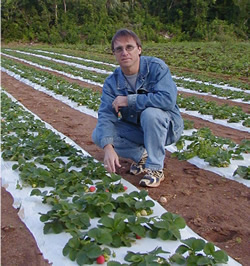
More expensive in Bermuda than anywhere else in the world, but among the nicest anywhere. Following the introduction of all fruit from England, figs, pomegranates, lemons, shaddocks and more once grew here in abundance and were exported to England and America, but no more. Locally, many rents were once paid in fruit. They are grown in sheltered orchards and usually not visible. Local fruits are so much more tasty than the imported varieties. The list includes the following:
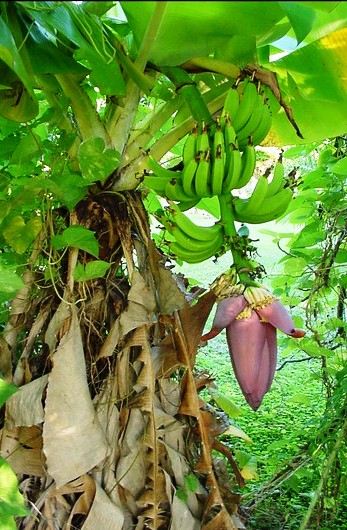
Bermuda-grown bananas
Since February 5, 2016 the Bermuda Government has been attempting, without success so far, to cultivate new varieties of banana — in case the fungus decimating the fruit’s global population reaches the island. The new strain of Panama disease, a resilient and incurable soil fungus also known as fusarium wilt, has already torn through crops in Australia, the Middle East, Asia and Africa. Should the fungus arrive in Bermuda, it could have a “devastating impact” on the local banana culture. Fusarium wilt is a serious threat to banana production worldwide. Locally, the department is investigating other varieties of bananas in order to diversify should something happen to the Cavendish stock. It is not likely that new varieties will be able to match the productivity of the Cavendish, unless they are genetically modified. The Plant Protection Lab has identified sources for new and alternative banana varieties. There are stringent guidelines in place to prevent accidental importation. In 2019 and 2020 the supply of imported bananas was interrupted when diseased bananas were found. In Bermuda, they are now the world's most expensive bananas.
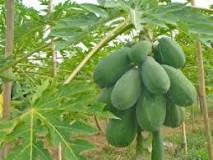
A few locals have grown small private quantities of pear, plum and pineapple, but the soil may not be suited for them.
![]()
![]()
More expensive in Bermuda than most other places. Bermuda imports 99% of everything, including the seeds used to plant vegetables. However, fresh carrots - Daucus carrota sativa - must be locally grown, are on permanent embargo to help prevent the introduction of the Carrot Rust Fly, a carrot attacker. Local carrots enjoy this special protection year round. The downside of this immigration policy for carrots to local residents is that when weather conditions affect local supply, frozen and canned carrots are the only alternatives.
There is no organic vegetable certification authority. Local production of non-organic vegetables is concentrated mostly on two local farms. Both are insufficient to satisfy the needs of locals and visitors.
Bermuda has three seasons, but some put in a fourth crop for potatoes (white or Irish and sweet, see note below), okra, tomatoes, watermelon and cantaloupes. Locally grown vegetables are artichokes, beans (bush and pole, runner, string, snap, broad), beets, Bermuda Onion (Allium cepa), Bermuda cassava, broccoli (a good host plant for caterpillars and their butterflies (Cabbage White), Brussels sprouts, cabbage (Chinese and regular), cantaloupe, carrots, cauliflower, celeriac, celery, chard, chicory, chives, christophene, collards, corn, cowpeas, cucumbers, dasheen, eddoe, eggplant, endive, escarole, Florence fennel, garlic, herbs, Jerusalem artichokes (H. tuberosa), kale in all varieties, kohlrabi, leaf lettuce, leeks, mustard greens, okra, onions, papaya, parsnips, parsley (Petroselinum crispum, grows wild on some coastal hillsides, introduced to Bermuda from the UK in 1612), peas, peppers, potatoes and sweet potatoes, pumpkin, radish, rutabaga, salsify, scorzonera, shallots, snap beans, spinach, summer squash, squash, strawberries, sweet corn, Swiss chard, thyme, tomatoes (Lycopersicon Lycopersicum) grown all year in Bermuda, introduced from England after England got them from Spain, first recorded in Bermuda in 1851 when 10 boxes were exported, regularly sent by ship to New York in the late 1870s and early 1880s in 10-pound crates or palmetto baskets), turnips, upland cress, watercress and zucchini.
Earlier, potatoes were mentioned. They have a unique Bermuda history, dating back to 1609 when they arrived by accident. They were intended for planting in Virginia and first carried on the Sea Venture in 1609. They were to be grown by British colonists in the New World, but for them this first occurred not in the USA but in Bermuda. (According to http://en.wikipedia.org/wiki/Potato, it originated in Peru). It apparently went from Peru to Europe. The history of the Jamestown colonists has proven they did not have or grow white, red or sweet potatoes before 1612, there was no trade at that time between Jamestown and Peru and that they did in fact get their first shipment from the British colonists sent from the UK to Bermuda. This does not claim this is how the American white, red and sweet potato started, it merely says and has been proved that the first shipment of white, red and sweet potatoes seen in Jamestown came from Bermuda. They were grown there by the castaways before they brought or sent them to Virginia.
![]()
![]()
Authored,
researched, compiled and website-managed by Keith A. Forbes.
Multi-national © 2020. All Rights Reserved